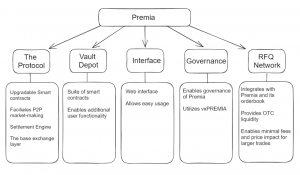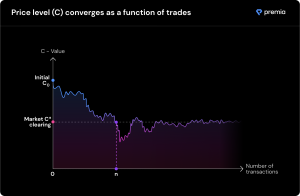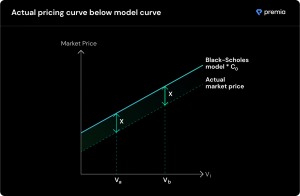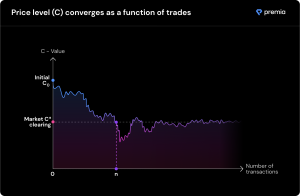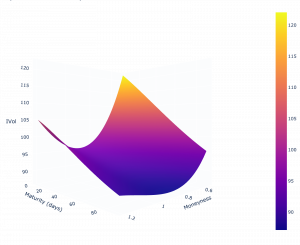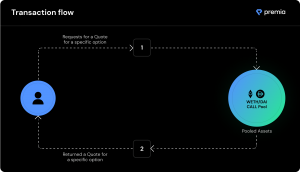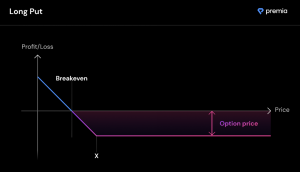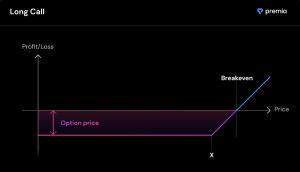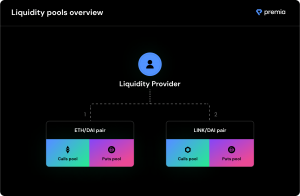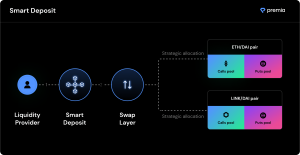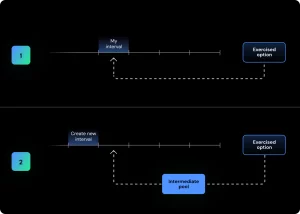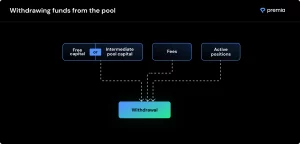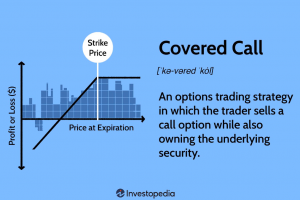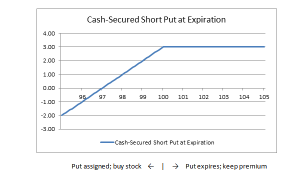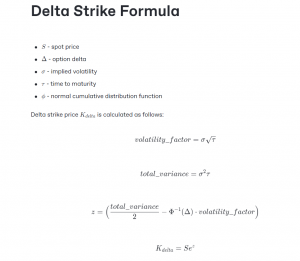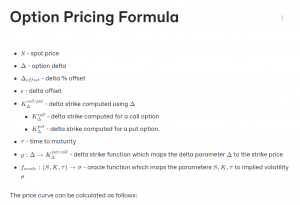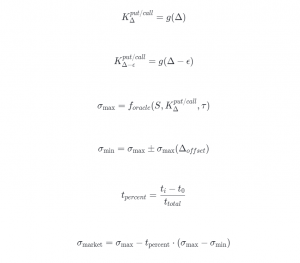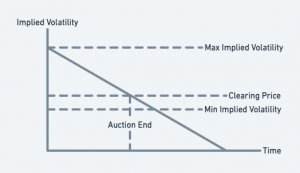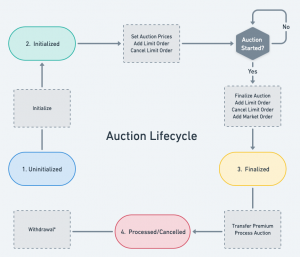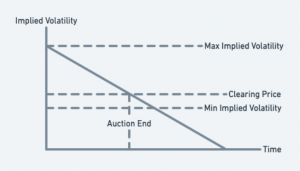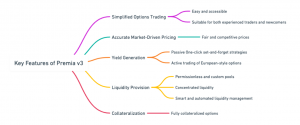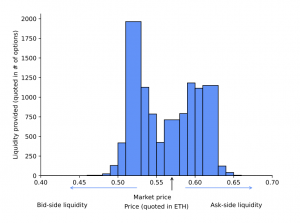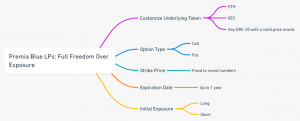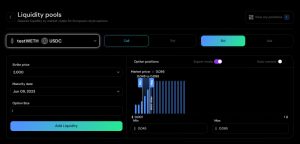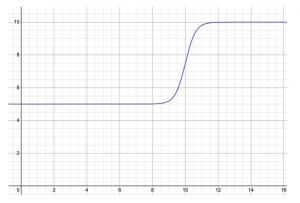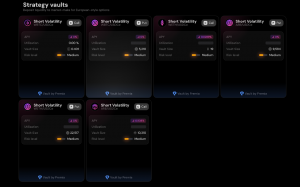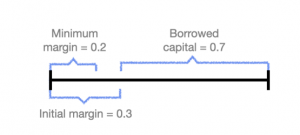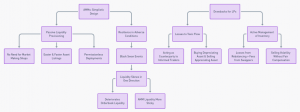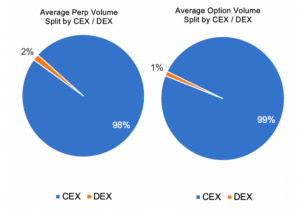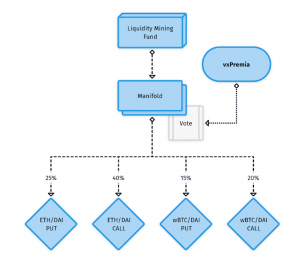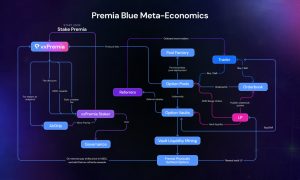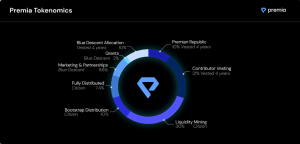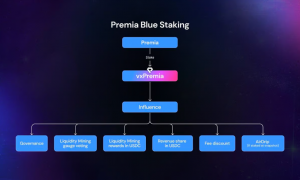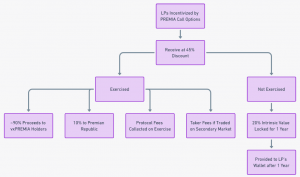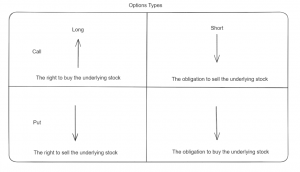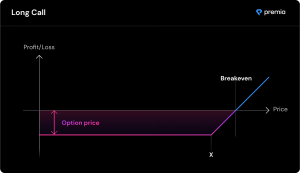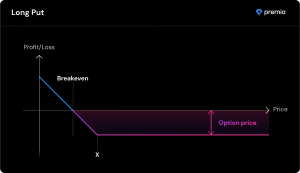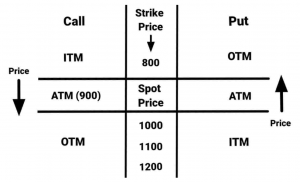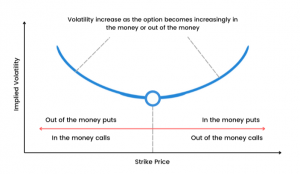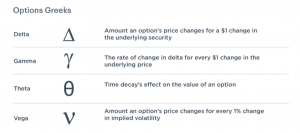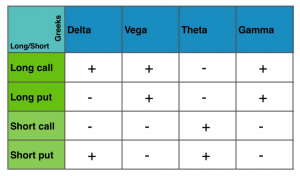Introduction
Designed for the Ethereum Virtual Machine, Premia is a peer-to-peer options exchange and settlement engine. With an emphasis on options trading, the protocol’s goal is to produce a set of smart contracts that prioritize security, self-custody, and autonomous execution without the need for a trusted middleman.
Premia has gone through multiple iterations, upgrading itself since launching in early 2021. It is currently operating both the v2 (live only for LPs to access their liquidity and for migration purposes) and the v3 version.
There are currently 5 different areas of Premia, which are the following:
- The Premia Protocol: A suite of upgradable smart contracts that together facilitate peer-to-peer market making and trading of options on ERC-20 tokens available on the Ethereum blockchain along with a settlement engine. This can be thought of as the “base” exchange layer.
- Premia Vault Depot: A suite of in-house and third-party smart contracts composed on top of The Premia Protocol, that enables additional user functionality such as participation in automated strategies, leverage, and risk management on the EVM.
- The Premia Interface: A web interface that allows for easy interaction with the Premia protocol. The interface is only one of many ways one may interact with the Premia protocol, and is actively maintained by the Premia governing body.
- Premia Governance: A governance system for governing the Premia Protocol, enabled by staking PREMIA tokens and receiving vxPREMIA.
- Premia RFQ Network: An RFQ system that seamlessly integrates with the Premia Protocol, and its orderbook, and provides Over-The-Counter (OTC) liquidity, enabling direct trading between two parties. This results in minimal fees and price impact for larger trades, making it an ideal solution for high-volume or specific order requirements.
Premia: History and Background
Premia V1
Launched in 2021, Premia V1 predated L2s and operated as a peer-to-peer options trading platform, featuring an OTC market for on-demand and on-match trading.
Premia V2
In 2022, Premia v2 transitioned to a peer-to-pool model, primarily targeting retail traders. However, this version lacked the flexibility to parametrize the options being sold, limiting customization and making it less appealing for more professional users.
With the launch of Premia Blue (v3) on Arbitrum, v2 would undergo a deprecation on all chains other than Optimism, with the following changes:
- Deposits and trades will be disabled, but withdrawals will be available until the last non-Optimism v2 option expires.
- All liquidity mining rewards have now been redirected from Premia v2 pools to Premia Blue vaults in the form of Options Liquidity Mining (OLM).
Essentially, v2 would only be kept available for the purposes of accessing already existing liquidity and migrating to Premia Blue.
Optimal Pricing Algorithm (V2 C-level Vaults)
Premia’s pricing algorithm is designed to address the unique challenges presented by the cryptocurrency options market. Unlike traditional financial markets, crypto options trading operates in a distinct microstructure, and conventional pricing models like the Black-Scholes or Binomial Options Pricing Model (BOPM) are not well-suited due to various deviations from their underlying assumptions.
- Traditional options pricing models assume market efficiency, zero transaction costs, known and constant risk-free rates and volatility, and normally distributed returns on the underlying asset.
- These assumptions don’t hold in the crypto market, making traditional models ineffective and potentially leading to significant losses for liquidity providers (LPs) or unrealistically high option prices for buyers.
Instead of relying on traditional models, Premia’s pricing model is liquidity-sensitive and incorporates market adjustment mechanisms. This way, The price of options is determined by the relative supply and demand of capital within each pool, allowing market forces to converge toward the true market price. This approach leads to higher capital utilization within pools, potentially reaching 100% utilization, resulting in better returns for LPs without increasing prices for buyers.
- Market supply and demand dynamics are central to determining option prices through a risk-adjusted model.
- The pricing model ensures that, even under volatile user behavior, option prices converge to the true market price.
- In equilibrium, capital utilization within pools is influenced by market returns, typically ranging from 85% to 95% in simulated models, depending on user behavior.
- Higher pool utilization benefits LPs with improved returns while maintaining competitive pricing for buyers.
The Pricing Model
Premia employs a liquidity-sensitive pricing model based on the Black-Scholes framework, adapted to the unique characteristics of the crypto options market. This pricing model is designed to find an equilibrium between option prices, taking into account various market factors.
Inputs Required:
- Strike price.
- Spot price.
- Option maturity.
- Implied volatility.
- Risk-free rate of return.
- Position size
In addition to the input parameters that are used in Black-Scholes, Premia also takes into account the position size.
This results in a 5-dimensional input vector denoted as Vi.
The traditional Black-Scholes model is used as a starting point, but Premia assumes the existence of a theoretical market pricing curve that reflects the true market clearing prices for options based on various input vectors (Vi).
Deviations from the traditional model’s assumptions are expected but are not assumed to significantly alter the shape of the equilibrium pricing curve when compared to the Black-Scholes dynamic-hedge-based model.
Linear Relationship Assumption
Premia assumes a linear relationship between the actual market pricing curve and the Black-Scholes suggested curve. This relationship is assumed to be consistent across different values of Vi.
For instance, if one option is underpriced by 10% according to the Black-Scholes model, another option with different parameters should also be underpriced by the same percentage.
Letting Market Forces Demonstrate the Relationship
The key to understanding this relationship is to allow market forces to quickly converge towards it. For that reason, Premia’s pricing mechanism involves three main parts:
- Original Black-Scholes Model.
- Current pool price level, adjusted for the impact of option size.
- Discrete liquidity adjustment coefficient to update the price level.
The Formula
- The price quoted by the pool for an option at a given time t (Pt) is calculated as the product of the Black-Scholes model output (BS(Vi)), and a liquidity adjustment coefficient (C*t).
- The liquidity adjustment coefficient accounts for the impact of option size and is adjusted based on the pool’s size and the size change caused by a purchase. This adjustment is performed with the help of trade-specific steepness parameters (ax).
- The model can result in option prices that are lower than the intrinsic (exercise) value when the liquidity level is very low.
- To protect liquidity providers (LPs), Premia implements a Minimum Return model, ensuring that the final option price offered by a pool is always at least as high as the intrinsic value of the option plus a minimum annualized return, even if the standard model suggests a lower price.
This pricing mechanism aims to strike a balance between the Black-Scholes model and real market dynamics, considering liquidity and trade-specific parameters to provide competitive and LP-friendly option prices.
- Pt: Price quoted by the pool for an option at time t.
- BS(Vi): Black-Scholes model output for the selected option, based on a 5-dimensional input vector Vi (spot price, strike price, maturity, implied volatility, risk-free rate).
- Ct: Pool price level (liquidity adjustment coefficient) at time t (current period).
- (C*t): Pool price level adjusted for the price impact of option size.
- St: Pool size at time t (current period).
- St+1: Pool size after purchase (at time t+1).
- (ax): Trade-specific steepness parameter, currently defaulted to 1 for all trades (no effect).
- Pt is calculated by multiplying the Black-Scholes model output BS(Vi) by a liquidity adjustment coefficient (C*t).
- (C*t) is determined by multiplying Ct by an integral term.
- The integral term involves an exponential function with a parameter x and a multiplier (ax). The denominator of the fraction within the integral term calculates the price impact of the option size change, taking into account the maximum of either St+1 or St.
- Additionally, Ct+1 is calculated based on the current Ct and the price impact factor with ax as an exponent.
How Price Converges
Premia’s pricing model employs a continuous, on-chain reinforcement learning mechanism to achieve price convergence towards the optimal market price and liquidity utilization rate over time.
This is achieved by taking the following assumptions:
- Market participants collectively know the market clearing price for any option.
- If the pool’s quoted price is higher than the true market clearing price, option buyers purchase fewer options, and LPs provide more capital.
- If the pool’s quoted price is lower than the true market clearing price, option buyers purchase more options, and LPs provide less capital.
- Option buyer demand can only be observed when a purchase is made and capital within a pool is locked as “booked.”
- Participants act rationally, but some bursts of random behavior are tolerated, as long as they do not significantly exceed the variance of the rational behavior model.
This results in the following convergence process:
- Initialization: At the start, there are zero assets in the pool, and an initial guess, C0, which is used as a multiplier to adjust the Black-Scholes model output (BS(Vi)) to produce the option quote provided to buyers. For example, suppose C0=5.
- Step 0: Since the pool intentionally overprices options at initialization, LPs are motivated to provide capital, expecting above-market returns. For example, an LP provides 100 ETH. At this point, the pool doesn’t adjust the C-value.
- Step 1: Options are still overpriced, attracting more LPs to provide liquidity. Suppose another LP joins with an additional 100 ETH. Now, the pool observes that market pressures favor the supply of liquidity.
- The “step size” is calculated as the relative change in available liquidity compared to the previous state, which is 0.5 in this case.
- The step size is used as input to an exponential decay function, resulting in a multiplier (0.6065 in this example).
- This multiplier is applied to the initial guess (C0) to update the belief about the market clearing C-value.
- The improved guess after step 1 is now C1=5*0.6065=30325, which is much closer to the market clearing C-value of 2.
- Repeat Steps 0-1: The process continues, with LPs providing more capital as the pool’s quoted prices become closer to the market clearing price.
- The C-value goes up and down, eventually converging to within a small percentage error of the market clearing conditions.
This results in the following convergence characteristics:
- The price level steadily trends towards the market-clearing C-level over time.
- Despite the volatility in user behavior, option purchases continue even if the buying price has not yet reached market equilibrium, leading to fluctuations in the C-value.
- The convergence process is conditional on the initial guess C0 being set above the market clearing level.
Therefore, the initial C0 value significantly influences convergence dynamics. Higher initial values increase the likelihood of asymptotic convergence, but this relationship may change for models with a limited step count.
Similarly, the exponent base in the model impacts the convergence profile, and finding the ideal characteristics of a healthy market convergence process is an ongoing exploration.
Further exploration may involve alternative base pricing models to Black-Scholes and the possibility of using multi-dimensional C-values tailored to option strike price and maturity for more optimal pricing.
C-Level – Capital Pricing and Initial Liquidity
Every pool has a C-level (price level) at any given time.
- The C-level is a dynamic multiplier applied to the base Black-Scholes model to adjust option prices.
- When the C-level is high, options are more expensive, leading to higher premiums earned by Liquidity Providers (LPs) on their capital.
- LPs are incentivized to provide liquidity to pools with high C-levels.
- Each pool is initialized with a high C-value, offering early LPs the potential for above-market risk-adjusted returns.
When a pool is created, it is initialized with a high C-level value. This high initial C-level is set intentionally to ensure that options within the pool are overpriced at the beginning. This initial overpricing benefits LPs.
As an LP, you are motivated to provide liquidity to pools with high C-levels because these pools offer the potential for above-market returns. Buyers may be willing to overpay for options in such pools due to irrational behavior or a strong desire for those options.
For instance, suppose a pool is initialized with C0=5. This means that initial pool prices are set to 5 * BlackScholesPrice.
Next, the C-level dynamically adjusts after every trade within the pool. As LPs deposit more capital into the pool, the C-level decreases. Conversely, when options are purchased (removing free liquidity from the pool), the C-level increases.
Over time and after a certain number of transactions (represented as “n”), the pool’s C-level converges to a market-clearing C-value (not observable). Once this convergence occurs, LPs will earn market-competitive returns on their liquidity.
- Before the C-level reaches its market-clearing value, there are likely to be buyers willing to pay a premium for options. This early stage of the pool’s existence provides LPs with above-market, risk-adjusted returns on the capital they deploy.
- Due to Premia’s pricing mechanics, each pool is designed to converge towards a theoretical 100% utilization. This means that none of the LPs’ capital should sit idle; it will be incentivized to be utilized at the best market return.
The Liquidity Buffer is created by the initial overpricing (high C-level) before convergence to the market clearing C-value. It represents excess liquidity available in the pool. However, not all of this capital will be utilized initially, as it’s assumed to be overpriced. Over time, this buffer may decrease in proportion to the total pool size as the C-level approaches the market-clearing value.
C-level recovery
C-level recovery is a mechanism within Premia’s pricing model that enables pools to recognize and correct themselves when they enter unstable states. These unstable states are characterized by a mismatch between the pool’s C-level and its utilization rate, leading to fewer trades and deposits compared to equilibrium. There are two specific situations that can be considered unstable:
- High Relative Pool C-level with Low Pool Utilization Rate:
- In this scenario, the C-level is relatively high compared to the pool’s utilization rate.
- This results in fewer trades being made than what would be expected at market equilibrium, and it does not incentivize additional deposits.
- Low Relative Pool C-level with High Pool Utilization Rate:
- Conversely, when the C-level is relatively low compared to the pool’s utilization rate, it can also lead to instability.
- In this case, the pool is highly utilized, but the low C-level does not encourage further deposits.
C-level recovery is designed to mathematically identify when a pool enters one of these unstable states and gradually corrects itself to return to a more stable state over time.
- Identifying Unstable States: When the C-level is in an unstable state, such as a high C-level with low utilization or a low C-level with high utilization, the system recognizes it as an unstable condition.
- Automatic Convergence: The C-level then starts to naturally converge back to a more stable level, as long as there are no new interactions with the system for a certain period. In other words, if no trades or deposits occur for a while, the C-level will automatically adjust to incentivize further activity and restore stability.
For example, if a pool has a very high C-level but low utilization (perhaps after the initial deposit), and there are no buyers for some time, the C-level will automatically decrease to encourage the next buyer and rectify the unstable state. The same principle applies in the opposite situation, where a very low C-level exists, and there is minimal free liquidity.
Price Impact by Size
Premia’s pricing model includes a mechanism to account for price impact per size, which helps disincentivize highly disruptive trades, especially those made by large traders. The goal is to maintain market stability and ensure that all traders, regardless of size, are treated fairly.
After every transaction, the pool’s price level is updated from Ct (the current price level) to Ct+1 (the next price level). This update is based on the size and direction of the trade and results in either an increased or decreased price for the next buyer or underwriter.
Premia’s pricing model takes into account the potential for large traders (“whales”) to disrupt the pool’s price level. For example, if a whale intends to make a massive purchase when the C-level falls below their perceived market equilibrium, it could significantly disrupt the pool’s price.
To mitigate such disruptions and ensure that large traders do not have an unfair advantage, a price impact penalty is imposed on the whale. If the starting price level is Ct, and after the whale’s trade, it becomes Ct+1, where Ct+1 > Ct, the price impact penalty is calculated as follows:
- In discrete form, the whale would end up paying:
- In differential form, a more accurate representation is used to calculate the price impact penalty:
Implied Volatility
Implied Volatility (IVOL) is the annualized volatility implied by an option’s price. It represents the market’s expectation of an asset’s future volatility based on the option’s current price. In mathematical terms, IVOL can be determined by plugging the final option price into the original Black-Scholes equation and solving for σ, which is the volatility parameter implied by the price.
The challenge with IVOL is that it creates a chicken-and-egg problem. In modern Black-Scholes models, option prices are often determined by plugging in an implied volatility value (IVOL) into the model instead of σ. This means that IVOL is used to calculate option prices, but option prices are needed to calculate IVOL. This creates a circular dependency.
Also, IVOL is not a single value but a three-dimensional concept. It depends on three factors: the option’s maturity date, whether it’s “in-the-money” or “out-of-the-money,” and the strike price of the option. This complexity is why IVOL is often referred to as the IVOL surface or Volatility Surface.
For any asset, there exists a theoretical market IVOL surface that is known only to market participants and cannot be directly observed or derived from external data. Until this true IVOL surface is known, there will always be an approximation error in IVOL calculations, which can skew the prices of options in favor of either the Liquidity Providers (LPs) or option buyers.
Due to the decision-making nature of option buying, option buyers are more likely to engage in trades they perceive as favorable, shifting the inefficiency onto the LPs who underwrite the options.
The approach to dealing with this challenge has two main objectives:
- Propose a Starting Point for IVOL: To propose the best possible starting point for IVOL, even in the absence of knowledge of the true IVOL surface.
- Minimize Adjustment Costs: To minimize the cost of adjustments required to converge to the true market IVOL when it becomes known.
Volatility Surface Research
Given the constraints imposed by the underlying blockchain technology, Premia’s approach to solving the volatility surface problem must be not only innovative but also practical.
- Initial “Best Guess” for Volatility Surface: Premia starts with an initial “best guess” for the volatility surface. This initial estimate covers a limited range of inputs, including maturities ranging from 90 days and moneyness (the ratio of the option’s strike price to the current asset price) between 0.8 and 2.0. These inputs represent the most often traded strikes and maturities. The central area of the volatility surface, where these inputs lie, is more consistent and stable compared to the less-traded edges.
- Pinching the Volatility Surface: Any trade, weighted by its magnitude, has the effect of “pinching” the volatility surface. This is analogous to pinching and pulling a bedsheet. The point where the pinch occurs has the most significant effect, but the areas around it are also affected to varying degrees, depending on their proximity to the pinch point. The key design decision is to minimize the amount of trading required to move from the initial best guess IVOL to the theoretical market IVOL by continuously pinching the surface.
- “Pinch” Event Selection: Certain events, such as the purchase of an option, are observable and cause upward pressure on the volatility surface at the corresponding maturity and strike price. However, the opposite pressures, such as LP deposits, are not as straightforward to observe in a pool-to-peer architecture like Premia. Identifying the complete set of pinch events is an ongoing research challenge for Premia.
- Objective of the Initial Best Guess Surface: The goal of the initial best guess surface is to minimize the total error from the theoretical market-clearing volatility surface. The key design decision is to approximate the order of magnitude of this error. For example, if the initial surface is expected to differ by no more than 10% from the theoretical surface, the maximum discount that can be imposed on LPs will correspond to the price decrease resulting from a 10% lower volatility input in the Black Scholes model. This allows for the design of incentive mechanisms that provide fair value to both LPs and option buyers.
- Exploration of Various Directions: Premia’s research into solving the Volatility Surface problem has explored multiple directions, including:
- Inferring dynamic IVOL surface from centralized finance (CeFi) platform data like Deribit and Binance Options.
- Inferring the initial best guess surface from historical pricing data using techniques such as static and dynamic replication models and Monte Carlo simulations.
- Inferring signals from primary and secondary DeFi market transactions, including those on the Premia platform itself.
Premia utilizes Chainlink to solve their need for a volatility surface oracle. Similar to existing Price Feed oracles, this oracle allows smart contracts to access on-chain data. Specifically, it provides a 3-dimensional volatility surface, a crucial component for accurate option pricing and risk assessment.
Due to Ethereum’s low-compute constraints, the volatility surface oracle calculates the ideal volatility surface off-chain. It uses a volume-weighted combination of data from the most liquid centralized exchange (CEX) options and trades executed on the Premia platform to create this off-chain volatility surface. This surface is then parameterized for on-chain representation as a simple polynomial, ensuring accurate pricing for any specific option.
Users and smart contracts can then interact with the Volatility Surface Oracle by calling specific functions. For pricing an option, the getBlackScholesPrice function is used, where users provide the token pair, option type (call or put), spot price, strike price, and maturity of the option. This function returns the Black-Scholes price with the volatility surface value applied to the σ parameter in the original Black-Scholes equation.
The volatility surface data isn’t limited to option pricing. Users can retrieve the entire surface by calling getVolatilitySurface with the token pair as a parameter. Alternatively, they can use getAnnualizedVolatility64x64 with the same option parameters to obtain a 64×64 fixed decimal representation of volatility for a specific option.
Trade Execution and Clearing
The Premia ecosystem of smart contracts offers non-custodial protections for liquidity providers and traders alike. Combining the distributed ledger equivalents of clearing houses and trading facilities, Premia offers best-in-class prices for shallow liquidity pools that scale with increasing deposits.
Being the first protocol to bring on-chain implied volatility oracles to EVM networks, Premia is able to properly map the implied volatility surface for mature crypto asset markets, as well as utilize a novel correlation approach to immature crypto asset derivative markets.
Transaction Flow
There are 2 pools for each asset pair on Premia: a Call pool and a Put pool. This allows both liquidity providers to granularly decide which pool they’d like to underwrite and option buyers to select which direction they’d like to trade.
When a user wants to purchase an option from the pool, they can simply send the details of the option they’d like to purchase to the pool, and the pool will return a quoted price for the user’s selected size, strike price, and maturity date. If the user agrees with the price, they can execute the trade with an on-chain transaction.
The option is then owned by the purchaser and represented as an ERC-1155 token in their wallet, allowing the user to transfer the option or exercise it at a future time.
Exercising and Settlement
When a user buys an option, they can exercise their option at any time after purchase. Options can be exercised in full or in partial amounts over time. If at the time of maturity, an option is In The Money, the payoff is locked in and can be claimed at any time post maturity by the owner of the option. There is no penalty for late exercising.
Exercising and settlement of a PUT option
If at the time of exercise, the price of the underlying asset is lower than the breakeven price, the put option is considered In The Money. In this case, the user is entitled to the payoff, which is equal to the strike price of the underlying minus the spot price. This difference is calculated automatically and settled in cash (the base token) to the option buyer.
Exercising and settlement of a CALL option
If at the time of exercise, the price of the underlying asset is higher than the breakeven price, the call option is considered In The Money. In this case, the user is entitled to the payoff, which is equal to the strike price of the underlying minus the spot price. This difference is calculated automatically and settled in the underlying asset (the quote token) to the option buyer.
Providing Liquidity
Each asset pair has 2 pools: a Call pool and a Put pool. Calls pools are underwritten in the underlying asset ($WBTC, $ETH, $LINK), and puts pools are currently underwritten in $DAI. This allows both liquidity providers to granularly decide which pool they’d like to underwrite and option buyers to select which direction they’d like to trade.
Each pool is described by the following parameters:
- Asset pair
- Total amount of assets
- Utilization ratio
Smart Deposit Router
The Smart Deposit feature is based on a standard mathematical procedure called portfolio optimization.
The user submits a total amount for the deposit and market sentiment, and the Smart Deposit computes the fraction of the deposit to be swapped and allocated per pool. Once determined, these allocations are recommended to the user.
The user is prompted to select a series of assets that they own and is then prompted to select their market sentiment. The market sentiment selection has one of three settings: “bullish”, “bearish”, and “neutral”. These settings determine which pools will be considered for deposit: calls, puts, or both.
The total value of their assets is then summed into a single nominal amount. The fractional pool allocations are then determined based on the “mean-variance” criterion with respect to the aggregate pool c-values.
The allocations recommended to the user simultaneously maximize the mean c-value and minimize the variance of the c-value across the selected pools, hence they are said to satisfy the “mean-variance” criterion. The c-value is a Premia-specific pool metric that summarizes the utility value of deposits in each pool. Because each c-value summarizes the utility value of its respective pool, the smart deposit recommends an allocation that maximizes the mean c-value across pools, hence maximizing the average utility of the user’s deposit.
Severe fluctuations in the c-value are assumed a priori to be undesirable, hence the smart deposit feature recommends an allocation that minimizes the statistical variance of the c-value across pools.
Pool Accounting and LP Returns
This is the first fair pool accounting mechanism on the market, developed by Premia, ensuring fair accounting for LPs, depending on when they got in the pool and how long their capital has been deployed.
Deposits
Deposits are sequenced on a first-in, first-out (FIFO) basis to ensure fairness.
Depositing (adding liquidity to a pool)
- Select pool
- Select Amount
- [optional] Select swap asset
- Confirm transaction
All of the available liquidity (Free Capital) in the pool, is sequenced in terms of intervals.
Each interval is defined by 3 parameters:
- LP wallet address
- Interval number
- Interval size
Underwriting Options
Liquidity providers automatically underwrite options purchased by users of the Premia pools.
When an option is purchased, the following steps happen in a transaction:
- Scans intervals required to underwrite position
- Mints tokens for interval owners
- Calculates option expiration date
- Places purchased option in ordered list, by expiration date
- Updates starting point of Free Capital
Options Expiration and Exercise
An option can complete its lifecycle in one of two ways: either be exercised or expire worthless. Liquidity providers can still withdraw their liquidity from their intermediate pool at any time.
For that, Premia utilizes automated tools such as Chainlink Keepers to process expired options daily, to ensure maximal capital efficiency and the best user experience for users of the protocol.
When an option is exercised, the same transaction settles the position – the option holder receives the payoff, and the newly freed capital is returned to the pool.
If an option expires without being exercised, the value of the option at expiration is locked in the option, allowing the option to be processed by any user of the pool. Users (or Chainlink Keepers) can then call processExpired on the pool to automatically free capital in the next expired option and send the exercise reward to the option holder. This ensures the pools stay maximally capital efficient and users always receive the best returns possible.
Liquidity providers’ capital is organized on deposit into Free Capital intervals, to ensure the fair sequencing of underwritten options. When an option is settled, for the newly freed capital to be returned to a Free Capital interval, it either has to exceed the minimum interval requirement for a new interval to be created, or the LP needs to have an existing Free Capital interval.
If the LP has an existing Free Capital interval, the newly freed capital is added to this interval (the amount is increased). If the LP has no existing Free Capital intervals, then should the newly freed capital exceed the minimum interval requirement, it is added at the back of the queue.
However, if the LP does not have an existing Free Capital interval, and the newly freed capital is below the minimum interval requirement, it will be placed in an intermediate pool until enough capital is accumulated to meet the minimum interval requirement. The reason behind imposing a minimum interval requirement is to avoid unbounded capital fragmentation (think an option buyer having to scan 1,000 intervals worth 1 $DAI each, to buy a single option). This ensures gas prices stay optimal for users of the protocol.
Withdrawal
LPs can withdraw their free capital at any time and have a few options for withdrawing their active capital.
Liquidity providers can withdraw their unutilized free capital in a pool at any moment in time (including unused premiums). If an LP would like to remove active (underwritten option) capital from a pool, they have two choices. They can either pay the pool price to sell the option to another underwriter in the pool, or they can use the Gradual Withdrawal feature to prevent their capital from being used to underwrite future options after expiration.
At any given time of withdrawal, an LP can have up to 3 components to consider:
- Free capital (or intermediate pool capital).
- Accumulated premiums.
- Active positions underwritten.
At the time of withdrawal request, the amount available for withdrawal is calculated as follows:
- WithdrawalAmount: FreeCapital + PremiumsEarned + AvailableActiveCapitalWithdrawalAmount
- FreeCapital: Amount of free/intermediate capital available
- PremiumsEarned: Total premiums accumulated from option sales
- AvailableActiveCapital: Sum(OptionSize∗(1−OutstandingExposure)
- OutstandingExposure: Outstanding pool value of underwritten options
Alternatively to the complete withdrawal of active funds (at cost), an LP can select a gradual withdrawal. This will prevent the user’s capital from being used to underwrite future option sales. As soon as capital is released from unwound positions, it is blocked from re-converting to free capital and can be withdrawn by the user.
Meta-Vaults: Aggregated Pool Strategies
Meta-Vaults were initially designed to embed various LP strategies into new pools of liquidity that implement the strategies automatically. This is made possible by the Premia base pool architecture.
As an LP, on several other platforms, you are forced to take a universal “short volatility” position (i.e. underwrite calls and puts simultaneously), which can often be a losing bet in crypto. This is not the case on Premia, which enables asset and direction-specific option pools.
Using the Premia option pools you could embed strategies such as:
- Optimizing for $PREMIA token farming.
- Deploying capital on momentum (when a C-level within a pool changes).
- Delta-hedging and other hedging strategies involving Greeks or spreads.
- Shorting volatility for specific assets.
- Options arbitrage between different platforms.
Most of these meta-vault strategies will only be possible on Layer-2’s with highly decreased gas costs compared to Ethereum mainnet. The current cost of gas on Ethereum mainnet makes most of these strategies unviable in a capital-efficient manner (the strategies lose money due to gas costs or cannot efficiently run the strategy due to capital requirements).
The initial research and vision for the meta-vaults lives on inside Premia Blue (V3) as Strategy Vaults.
Knox Vaults (V2)
Knox Vaults offers DeFi Option Vaults (DOVs) designed with a focus on risk management and yield generation. They are benchmarked on simplicity and outperforming HODL strategies.
These vaults are automated platforms that facilitate the process of selling options via auction to generate consistent and low-risk yield on crypto assets such as $USDC, $BTC, and $ETH.This is achieved by underwriting options, which involves selling call or put options depending on market sentiment.
With Knox Vaults Premia primarily offers two types of DOVs:
- Covered Call Vaults: These vaults involve selling covered call options. In a covered call strategy, the seller (the vault) owns the underlying asset and sells call options on that asset. This strategy aims to generate income while still maintaining exposure to the asset’s potential price appreciation.
- Cash-Secured Put Vaults: These vaults focus on selling cash-secured put options. A cash-secured put involves selling put options while setting aside enough cash (or collateral) to purchase the underlying asset if the option is exercised. This strategy aims to generate income while also having the potential to acquire the asset at a lower price.
This is achieved using American options issued as ERC-1155 tokens by Premia. These tokens offer the holder the rights (but not the obligation) to buy or sell the underlying token by a specified date.
While traditional stock option contracts usually represent 100 shares of the underlying stock, options on Premia represent the same number of tokens as described.
The option strike prices are determined once per epoch using the Delta Strike Formula.
Once pricing is determined, the options are sold via Dutch auction. The premium paid by the option buyers represents the weekly yield for depositors.
Knox Vaults also provides risk management tools within the vaults. For instance, an immediate withdrawal feature offers users the flexibility to exit their positions at any time during an epoch.
Users can initiate a transaction to receive their share of assets held within the vault. Typically, users receive short tokens representing the collateral held by the vault. Once users have these short tokens, they have two options:
- Hold Until Expiration: Users can hold these tokens until the options they represent expire.
- Sell Back to the Pool: Users can go to Premia’s position page and sell their position back to the pool, provided there is sufficient liquidity.
This results in the following advantages:
- Immediate Liquidation: Users can liquidate their assets instantly if needed, providing them with flexibility and liquidity.
- Early Profit Realization: If the options they underwrote (sold) are moving in their favor, users can choose to take profits earlier in the epoch, though the amount may be less than the full potential profit.
- Risk Reduction: If the options they underwrote are moving in an unfavorable direction, users can reduce their risk by exiting the vault.
Covered Calls
Covered calls are a popular options strategy that involves selling call options on an underlying asset while simultaneously holding an equivalent spot position in that asset. This strategy is often used to generate additional yield on an existing asset position while maintaining exposure to potential price appreciation.
- Naked Calls: Writing call options without holding the underlying asset. Naked calls have unlimited downside risk for the option writer because they may need to purchase the asset at a higher price to fulfill the contract if the price rises significantly.
- Covered Calls: Writing call options while already holding an equivalent spot position in the asset. Covered calls are considered less risky because the option writer can fulfill the contract with their existing spot position, even if the asset’s price increases significantly.
As an example:
- Suppose Ethereum ($ETH) is trading at $1,500.
- An investor writes 10 call options with a strike price of $1,600, which means they are willing to sell their ETH at $1,600 if the options are exercised.
- In a covered call scenario, the option writer holds 10 $ETH as collateral.
- If the price of $ETH increases to $2,200 before the options expire, the covered call writer can fulfill the calls using their existing 10 $ETH and still make a profit equivalent to the premiums received when writing the options.
| Benefits of Covered Calls | Risks of Covered Calls |
| Generate Yield: Covered calls provide a way to generate yield on spot positions while maintaining a bullish outlook on the asset. | Asset Value Decrease: If the value of the underlying asset decreases, the dollar value of the spot position also decreases, potentially resulting in a loss. |
| Reduced Downside Risk: Compared to naked calls, covered calls have substantially less downside risk because the option writer holds the underlying asset to fulfill the contract. | Missed Appreciation: If the asset’s price significantly exceeds the strike price, the options are likely to be exercised, and the option writer may miss out on additional price appreciation above the strike price |
Vault System
Vaults are distinguished by their collateral asset ($wETH, $wBTC, $DAI, etc) and delta (bullish or bearish), and are accompanied by three other design components:
- Queues act as liquidity buffers for vaults, holding user funds until they can be deposited
- Pricers determine the strike price for options and auction pricing parameters
- Auctions sell options using a Dutch auction format
Epochs
Vaults work on a 7-day schedule (epochs) and start and end every Friday, 8AM UTC.
The epoch timeline is as follows:
- 24 hours before the start of a new epoch, on Thursday at 8AM UTC*, the strike price for that epoch’s auction is determined and the auction is initialized.
- The epoch starts on Friday at 8AM UTC*.
- The auction starts on Friday at 4PM UTC and lasts 30 minutes.
- The auction ends on Friday at 4:30PM UTC* and options are written. Note, the auction may end earlier if all available option contracts have been sold within the allotted time.
- Options expire at the end of the epoch, i.e. on Friday at 8AM UTC.
Selection Methodology
There are 2 methodologies to be aware of, the Option Delta and the Delta Strike Selection.
Option Delta:
Each vault has an option delta, which is defined as the amount an option price is expected to move based on a $1 change in the underlying.
If a call option has a $0.1 delta, the price of the option will increase or decrease $0.1 for every $1 change in the underlying. Calls have a range of delta values between 0-1, puts have a range between -1-0. As the option approaches expiration the delta for ITM options will approach 1 for calls and -1 for puts, while the delta for OTM options will approach 0.
For calls an exercised option represents “stock” purchased by the option buyer, likewise puts represent “stock” sold by the option buyer. For both calls and puts an OTM option after expiration has no intrinsic value. Keep in mind that the option delta is relative to the position of the strike price compared to the spot price of the underlying. In other words, an option further ITM will always have a higher delta than an option further OTM.
Delta Strike Selection:
Under the delta strike formula, we determine a strike price Kdelta at a specific option delta as a function of implied volatility σ. In other words, if we know σ, we can obtain Kdelta, provided that the spot price, time to expiration, and option delta are constants. We can therefore create vaults with varying levels of relative risk and return.
Options Pricing
Knox Finance will offer a certain quantity of options to be sold at a pre-specified time and pre-determined strike. The vaults enable price discovery to occur on-chain via a Linear Gradual Dutch Auction (LGDA).
During the allotted time period, options will be written at a price specified by a linear curve. The implied volatility of the option will start at a maximum value (σmax ) and it will be gradually decremented according to the remaining time in the auction to a minimum reserve implied volatility (σmin). A bidder will have the chance to secure this price for a given lot size, depending on how much capital has been utilized prior to their bid.
Options Auction
Knox Finance Vaults sell options every epoch using a Dutch auction format. Since the auction determines the price at which options are sold, it also determines the premiums that the vault’s depositors will earn for that epoch.
Dutch auctions are a type of auction whereby the price of an asset starts high and is gradually decreased as the auction progresses. The auction ends when there are enough bidders at or above a certain price, such that the entire lot of the asset can be sold at that price. Importantly, all successful bidders in a Dutch auction pay the auction clearing price.
Auctions last 30 minutes, with prices decreasing along a linear price schedule. The offset delta strike represents the further-OTM option strike, it’s calculated using a fixed percent offset from the delta strike.
Options cannot be sold below the minimum price:
- In case there are not enough bids at or above the minimum price to sell the entire lot of options, the auction will be completed partially and proportionally fewer options will be written that epoch.
- In case there are no bids at or above the minimum price, the auction will be canceled and no options will be written for that epoch.
An auction may be canceled if one of the following happens:
- The auction is initialized with an invalid configuration.
- The auction prices have not been set before the auction starts.
- The auction prices are initialized with an invalid configuration.
- The auction is not processed within 24 hours of the auction end time.
In the event an auction is canceled, the option buyers will be refunded the full amount paid.
Liquidity Providers
Liquidity providers in the vaults can take 3 actions, being depositing and withdrawing collateral, and redeeming claim tokens.
Depositing Collateral
Collateral ($wETH, $wBTC, $DAI, etc) is deposited into the queue where it remains until the epoch is processed once per week.
Knox Finance uses two types of vault tokens to keep track of new and existing deposits:
- ERC1155 claim tokens represent assets deposited into the queue that have not yet been moved to the vault, at a 1:1 rate
- ERC4626 vault shares represent shares of the vault assets
At the beginning of every new epoch, ERC1155 claim tokens are converted into ERC4626 vault token shares based on the vault’s current price per share.
Withdrawing Collateral
Newly deposited collateral is held in the queue until the start of a new epoch. During this window, you can always withdraw collateral, without restrictions, penalties, or fees.
Upon withdrawal, your ERC1155 claim tokens will be exchanged for collateral at the same 1:1 rate applied at the deposit. Remember that at the end of the epoch, any collateral in the queue will be moved to the vault, and different rules for withdrawal apply.
Once funds have been moved from the queue to the vault, they only can be withdrawn without taking any exposure to a short position after a new epoch starts (Friday at 8AM UTC) and before the auction starts (Friday 4PM UTC).
While the auction takes place, you cannot withdraw from the vault until the auction has been processed.
After the withdrawal lock is cleared, you can again withdraw funds, but you will take on exposure to any short positions assumed by the vault during the auction.
Redeeming Claim Tokens
When a deposit is made, claim tokens are minted in a 1:1 ratio to the amount of collateral deposited. At the beginning of every new epoch, ERC1155 claim tokens are converted into ERC4626 vault shares in an amount determined by the vault’s current price per share.
A vault share represents a proportional amount of collateral assets and option contracts underwritten by the vault. Claim tokens minted in a given epoch may be exchanged for vault shares in any subsequent epoch.
Claim tokens are automatically converted to vault shares on behalf of the user each time a user interacts with the vault (i.e. deposits, withdraws, or redeems). This prevents the accumulation of a large number of claim tokens (which by design are temporary).
Options Buyers
Option buyers can take 3 actions: buying, withdrawing, or exercising options.
Buying Options
You can place orders to buy options before or during the options auction. Both market and limit orders are supported. Knox uses a Dutch auction system, so no matter what type of order you use, you will always pay the clearing price.
The platform supports both Market and Limit Orders
- With a market order, you only specify the number of options you wish to buy and the maximum cost you are willing to pay. The amount paid by the buyer will be determined by the quantity of options being purchased and the price established by the linear price curve. Market orders may only be placed during the auction (Friday 4pm – 4:30pm UTC).
- With a limit order, you specify the number of options you wish to buy and the maximum price you are willing to pay per option. The amount paid by the buyer will be determined by the quantity of options being purchased and the price specified by the buyer. Limit orders may be placed once the auction has been initialized (Thursday 8am – Friday 4:30pm UTC), and may be canceled anytime before an auction has been finalized.
Orders are only filled if the order price is greater than or equal to the clearing price and there is sufficient liquidity to fill the order (utilization < 100%). Assuming sufficient liquidity, your order is filled at the clearing price reached at the end of the auction.
The difference between the amount paid and the cost and/or any unfilled amount is refunded to the buyer when they withdraw from the contract.
An order may also be partially filled if there is not enough collateral to meet the amount specified. In this case the difference between remaining collateral and the amount will be used instead, any unspent funds will be refunded to the buyer when they withdraw from the contract.
Withdrawing Options
You can withdraw options from Knox as ERC-1155 options tokens 24 hours after the auction has been processed. Withdrawals may be made at any time if the auction has been canceled.
- If you let in-the-money options expire before withdrawing them, they are automatically exercised. Upon withdrawal, you will receive the proceeds of the options (their intrinsic value) instead of ERC-1155 options tokens.
- When withdrawing options or proceeds from expired options, you also receive a refund for any unspent funds that were deposited when placing the orders to buy those options.
Here is a table of the most common scenarios and their outcomes when withdrawing:
| Expired | Scenario | Outcome |
| No | Your order was filled at the exact price you deposited | You only receive your fill |
| No | Your order was filled at a lower price than you deposited | You receive your fill and a refund for unspent funds |
| No | Your order was not filled | You only receive a refund |
| Yes | Your order was filled at the exact price you deposited | You only receive the proceeds of the options, if any |
| Yes | Your order was filled at a lower price than you deposited | You receive the proceeds of the options, if any, and a refund for unspent funds |
| Yes | Your order was not filled | You only receive a refund |
Exercising Options
Options purchased on Knox Finance are issued by Premia, which means they are automatically exercised upon expiry. Since they are American options, they can also be exercised manually any time before expiry.
With Premia’s design, options are settled in the underlying asset. When exercised or upon expiry, the intrinsic value of the option is paid directly to the option holder:
Premia Blue: Overview
Premia Blue, also referred to as Premia v3, is the latest upgrade of the Premia protocol, designed to simplify and democratize options trading within the DeFi space. Premia Blue marks a groundbreaking shift from the well-known DOV model with a hybrid approach. It’s the first protocol to successfully combine an on-chain orderbook, settlement engine, vaults, and concentrated liquidity pools into a non-custodial options exchange with the accessibility of trading APIs for programmatic traders.
This innovative blend caters to a wider audience, including experienced traders from platforms like Deribit, who prioritize low fees and precise options pricing.
This version of the protocol introduces significant advancements that enhance capital efficiency and composability. Most importantly, the protocol offers benefits for all types of users, regardless of their level of expertise (retail users, passive LPs, active market makers, protail (pro-retail, trading firms, arbitrageurs, etc.).
The Base Layer (The Exchange)
The base layer of Premia Blue is a complete rework of the protocol, focusing on capital efficiency with features such as:
- Concentrated Liquidity:
- Allows liquidity providers (LPs) to create positions in specific option pools with defined price bounds.
- Maximizes fee collection and capital efficiency for both active and passive traders.
- Partial Collateralization:
- Introduces margin architecture, enabling partial collateralization of options for select payoffs like spread strategies.
- Increases liquidity and efficiently-priced assets while maintaining solvency and eliminating counterparty risk.
- Transaction Fees & Revenue Share:
- Traders pay fees, with a portion going to LPs and protocol stakeholders.
- Users can stake $PREMIA tokens to collect fees and participate in protocol governance.
- Vaults & OTC Liquidity:
- Addresses challenges in granular options markets, enhancing accessibility and usability.
- Modular and Layered Protocol:
- Designed for maximum composability and upgradability on top of the base exchange layer.
- European-style Options Markets:
- Enables the creation of European-style options markets for any asset pair with an on-chain spot price oracle.
- Range Orders:
- Supports various types of range orders, each with specific functionalities to cater to different trading strategies.
- Margin System:
- Utilizes a risk-based model to assess user positions, incorporating attributes from traditional Reg-T and Portfolio Margin systems.
- Establishes lending markets to provide capital to option underwriters. (To be enabled later)
In order to minimize counterparty risk, options on Premia are fully collateralized. However, lending pools will be introduced in the future to increase capital efficiency and enable partially-collateralized positions.
| Option Type | Collateralization | Price Quoting | Price Range |
| Call | Fully collateralized by the underlying asset. | Quoted in the underlying asset | Range-bound to price range |
| Put | Fully collateralized by the strike amount in the quote asset | Quoted in the quote asset | Range-bound from 0 to strike price |
Although pairs can be deployed using any quote asset with a valid spot price oracle, most often the quote asset will be a stablecoin, such as $USDCe.
Premia relies on a hybrid exchange that integrates vaults, a concentrated liquidity AMM, and an orderbook. Trades in the orderbook are settled on Arbitrum One, but the quotes are provided on Arbitrum Nova in order to speed up transactions and increase efficiency.
While all options settle within their respective pools, it’s possible to interact with multiple sources of liquidity for the same option. Users of the Premia Interface or Premia v3 SDK will have easy access to the best quotes from each source.
To be exact, for each given option, there could be up to 4 liquidity sources:
- AMM – Range Orders.
- Orderbook / RFQ System.
- Vaults.
- External Protocols / Third Parties.
Premia also offers an API and SDK for systematic traders, allowing them to plug and play their existing strategies and leverage them on-chain without even noticing that they are interacting with underlying smart contracts.
The determination of the settlement price is provided by an oracle feed that relies on spot price oracles, ideally corresponding at 8 a.m. UTC. In Premia Blue, pools can be created out of the box with:
- Chainlink VWAP Price Feeds
- RedStone Oracles (TBA)
- Third-party oracles that implement the IOracleAdapter smart contract interface.
- The UI will only display well-established price feeds.
The AMM
In DeFi, most Automated Market Makers (AMMs) operate using Constant Function Market Makers (CFMMs), where a trading function governs the exchange of assets. However, Premia takes a different approach. Instead of employing a trading function, Premia’s AMM relies on a linear relationship between price and liquidity. This unique approach is made possible due to the range-bound nature of option prices.
Option prices inherently have a defined price range, typically from ‘a’ to ‘b’, and this range is divided into active tick ranges with associated liquidity ‘L’. For example, if the current price ‘p’ is at the lower bound ‘a’, the AMM’s price formula is used to determine the price for any trade size ‘x’ within the active range.
The price of an option is calculated using the following formula:
- ‘x’ represents the trade size.
- ‘a’ and ‘b’ define the lower and upper bounds of the price range.
- ‘L’ is the available liquidity within that price range.
As an example, assume the following:
- There’s 3 units of liquidity deposited in the price range of 0.2 $ETH to 0.22 $ETH.
- The current market price is at 0.2 $ETH.
- An individual liquidity taker (LT) wants to buy 1.5 long contracts.
According to AMM’s formula, when the LT buys 1.5 long contracts, the market price will move to 0.21 ETH because half of the order is filled, and the formula guides the price change.
Now, the quoted price per option is calculated as follows:
So, the LT will receive 1.5 long contracts in return for 1.5 * 0.205 = 0.3075 $ETH.
Concentrated Liquidity
Premia’s AMM is a Concentrated Liquidity AMM (CLAMM), allowing LPs to deploy capital to a specific price range, maximizing utilization, and increasing the amount of fees that can be generated per unit of liquidity. This feature is relevant for the most sophisticated users and offers benefits such as:
- Enhanced capital efficiency: LPs can manually set the range at which their liquidity will earn the most fees.
- Maximize liquidity utilization & trading fees: As LPs are incentivized to provide liquidity to the optimal range, capital is used to its maximum efficiency.
When done effectively, LPs get the best fees, while traders get the most liquid markets possible. However, there is a degree of complexity associated with optimally managing positions.
- The most sophisticated traders will be able to maximize the amount of fees they can collect with more concentrated orders.
- Passive LPs with less conviction trades can still earn fees by selecting a wider and less capital-efficient range.
Options positions are represented as fungible and transferable ERC-1155 tokens.
Range Orders
Premia’s concentrated liquidity system offers a unique approach to range orders, providing liquidity providers (LPs) with the ability to calibrate their exposure and define upper and lower bounds for premiums. Unlike Uniswap v3, where a single range order suffices, Premia’s options market requires two distinct range orders to manage exposure effectively: Collateral-Short (CS) and Long-Collateral (LC).
CS and LC range orders in Premia enable traders to fine-tune their exposure to short and long positions within defined price ranges. These orders are adaptable to the current market price and provide flexibility for risk management and trading strategies.
The Premia team recently made public an open-source Range Order Bot for programmatic traders, which can be found here.
Collateral-Short (CS) Range Orders
CS range orders allow traders to manage their short exposure within a specified price range.
Traders can deposit both collateral and short contracts into the range order, and the composition depends on the current market price.
- When liquidity is deposited above the market price (p), the entire deposit consists of collateral. This collateral is used to underwrite options, serving as liquidity for traders buying long contracts. As liquidity takers (LTs) buy long contracts, the market price increases and the CS order is traversed. This means that the deposited collateral is gradually used to cover the increasing market price due to long contract purchases.
- Conversely, if liquidity is deposited below the market price, the deposit comprises short contracts. These short contracts will be bought-to-close as the market price moves upward. This process unlocks the remaining stored collateral.
- A CS range order that straddles the market price will have a mix of collateral and short contracts, optimizing exposure management.
For instance, let’s examine a scenario involving a range order’s liquidity profile placed above the current market price. As liquidity takers (LTs) engage by purchasing long options, the market price progresses through the range order, leading to specific outcomes. In the illustration below, you can observe that once the market price reaches the upper tick price (0.22 $ETH), the entire range order becomes filled.
A full withdrawal would result in the LP obtaining 0.63 $ETH and 3 short positions.
Long-Collateral (LC) Range Orders
LC range orders serve a similar purpose but are used to manage long exposure within a specified price range. The composition of LC orders also depends on the market price:
- Liquidity deposited above the market price consists entirely of long contracts, which are sold to reduce long exposure.
- In contrast, liquidity deposited below the market price is composed entirely of collateral, which is used to buy-to-open long contracts.
- A market order that straddles the market price will include a mix of both assets, facilitating balanced exposure management.
As an example, consider a range order within a put option pool, where liquidity is deposited above the prevailing market price. As the market price interacts with this range order, long contracts are sold to LTs, resulting in the transfer of premiums. Upon the completion of this movement, where the entire range is traversed, the liquidity within the position will consist entirely of the quote asset.
Custom LP positions
In Premia Blue, LPs have full control over their exposure: LPs can customize the underlying token, strike price, price range, and expiration date of the option they wish to market-make. If a pool doesn’t exist for the option, the LP can freely seed the liquidity to create one.
This unlocks unique opportunities for LPs, who will be able to use their capital efficiently while defining their own risk and setting the exact parameters that they want to underwrite for.
It is important to note that, In order to prevent excessive liquidity fragmentation and ensure maximum composability with other options markets, pools can only be created for common strikes and expirations.
- Strikes are algorithmically limited to common values (log-rounded)
- The maximum expiration is 1 year out.
- All options will expire at 8 a.m. UTC.
- All options with over 7 days to maturity expiring on a Friday
- All options past 30 days must expire on the last Friday of the month.
The Orderbook / RFQ System
The orderbook facilitates the intermediation between makers and takers.
| Market Makers | Market Takers |
| Provide quotes – either through the orderbook off-chain API or on-chain. | Obtain quotes off-chain through the orderbook API to fill the orders on-chain |
| When market makers submit quotes on-chain, an on-chain event is generated, recording the details of each order. | Once a taker selects a quote they wish to execute, the order details must be conveyed on-chain. |
| Each quote includes various parameters, including a deadline, which specifies the validity period of the quote. If necessary, orders can be canceled before the deadline (can only be performed on-chain) | Traders can verify the validity of a quote in the Orderbook |
The orderbook architecture is also unique in the sense that two separate chains are used:
- Arbitrum One acts as the primary chain where all orders are filled/canceled, and positions are settled/exercised.
- Arbitrum Nova is used for providing quotes in a decentralized yet low-cost and fast manner. Quotes are simply events that emit the order details by the maker of a transaction that will ultimately be processed on Arbitrum One.
There are two ways to emit quotes, either directly through the contract on Arbitrum Nova or through a rate-limited and tiered API.
Smart Liquidity Management
To solve the problem of liquidity management Premia offers a Smart Liquidity Management solution for its Range Orders system. One of the most notable features of this system is that range orders are one-sided and can automatically flip their directional exposure. This represents a massive improvement in terms of user experience.
- Range orders are “one-sided” which means that they can either be long or short orders.
- For long orders, the liquidity is used to underwrite long positions on that option.
- For short orders, the liquidity is used to underwrite short positions on that option.
- Range orders flip automatically, meaning that as the price moves along the LP’s range, the position will collect trading fees and the exposure will be updated. In practice, this means that LPs gain both short and long exposure to a given option automatically.
- Fees are collected both ways.
- Lower risk for LPs.
This provides an unparalleled degree of flexibility. As an LP, all you have to do is choose the underlying asset, the option type (call or put), the type of the range order (long or short), the strike price, the maturity date, and the size of the position along with the upper and lower price range.
From the point of view of an LP, the process is simplified as follows:
- Choose the underlying token.
- Choose the option type (call or put) and side of the range order (long or short).
- Enter the strike price, maturity date, and deposit amount.
- Define the upper and lower bounds of the range order.
- Provide liquidity and accept the transaction.
Exercise and Settlement
When a user is long (or short) an option, they can exercise (or settle) their option from the IPool interface at any time after the option’s maturity date. If at the time of maturity, an option is In The Money, the payoff is locked to the intrinsic value and can be claimed at any time post-maturity by the owner of the long option. Short option holders can also claim the remaining value of collateral at any time after expiration. There is no penalty for late exercising or settlement.
PUT option
If at the time of maturity, the price of the underlying asset is lower than the breakeven price, a put option is considered In The Money. In this case, the option owner (long the option) is entitled to the payoff, which is equal to the strike price of the underlying minus the spot price. This difference is calculated automatically and settled in cash (the quote token) to the option buyer. The option underwriter (short the option) is charged against the collateral held.
CALL option
If at the time of maturity, the price of the underlying asset is higher than the breakeven price, a call option is considered In The Money. In this case, the user is entitled to the payoff, which is equal to the strike price of the underlying minus the spot price. This difference is calculated automatically and settled in the underlying asset (the base token) to the option buyer.
Settlement Price (Oracle Feed)
Determining the settlement price is done via spot price oracles.
Margin
At a technical level, the margin system is a type of vault, and it is built on top of the base layer. This segregation from the base layer ensures solvency and the ability to guarantee payout as a settlement engine. Users who choose to utilize margin must do so through the margin vault. This experience is simplified for users of the Premia Interface or Premia v3 SDK. One of the major differences between using the margin and using the base layer is that positions held by users on the base layer can be withdrawn and freely moved. Conversely, positions that utilize margin can not be withdrawn.
The margin vault contains a blend of attributes from traditional Reg-T and Portfolio Margin systems that provide sell-side leverage. A risk-based model is used to assess user positions in an isolated fashion (per-position). In order for the base layer to always remain solvent, margin users must borrow capital from pool lenders, which is then used to fully collateralize the exposure on the base layer.
Borrowers are in a “first-loss” position relative to the lender. This means all losses incurred on a position are debited from a borrower before the lender takes on any risk. All profit is retained by the user borrowing capital, less capital usage fees (interest).
Providing Liquidity as a Lender
Lending markets are established exclusively for the purpose of providing capital to option underwriters, where each collateral type (eg. $ETH, $WBTC, $USDC) has its own margin lending pool.
When depositing capital into a margin pool, each lender must select a deadline on which their capital is to be returned. A lender’s capital can be borrowed at any time before the deadline (or indefinitely if no deadline is set). For example, if a lender’s deadline is 30 days from now, this implies the lender’s capital will be available for up to the next 30 days, and will only be used for options that expire between the current time and the deadline.
Any lender capital utilized in an option position is locked for up to the expiration of the position. Upon borrowing, a borrower pays an upfront interest-based commitment fee based on the utilization of the total available capital in the pool, up to the option’s expiration. When a borrower successfully closes a position, each lender’s capital is unlocked and immediately made available for further lending or withdrawal. At any time, lenders may withdraw any of their capital that is not being utilized in the pool.
A lender’s capital may be utilized for multiple options, so long as each expiration date is prior to the lender’s deadline. All lenders for a specific expiration share in lending fees pro-rata. Additionally, lenders split the principal risk of liquidated option positions, if and only if the Reserve Fund cannot fully cover losses. When a lender’s deadline is passed, their capital will be reserved for withdrawal and will no longer be available to be borrowed for margin.
If a borrower closes a position before maturity, they will be rebated with commitment fee claim tokens, enabling the user to claim any potential commitment fees generated by the returned capital, if borrowed again by another user prior to maturity.
Selling on Margin
- Lending Fee
In order to sell on margin, a user must borrow funds so that the position is fully collateralized. Borrowing these funds requires paying interest, which is paid up-front when a trade is opened. Any interest left over (i.e. a position is closed before expiration) is credited back to the trader upon closing the trade in the form or rebate claim tokens, which do not affect lender returns. The lending fee sits between the prevailing risk-free rate, R and R + .05. The amount of reserves relative to the amount of margined open interest determines where the interest rate will be. In other words, the more risk the lenders are potentially exposed to, the higher the interest rate charged up to 5% over the risk-free rate.
For example, if there is $100 ETH in the $ETH Reserve Fund, the first 100 short option positions opened on margin will borrow at the risk free rate. This is because there is no risk of loss to the lenders as any loss will be covered by the reserve fund. As the risk of loss to lenders becomes non-zero (the reserve fund capital becomes exposed), the interest rate will traverse to 10% to cover the risk of potential loss of their funds (as risk is transferred to lenders).
- Min Margin
Minimum Margin is the least amount of collateral a position needs to maintain before it will be liquidated. It is important to know that this is a dynamic number and will change over the life of a margined position based on several factors.
- Dynamics of Min Margin
The following are important terms related to dynamics of Min Margin.
- Time: As a function of time (all else equal), the Min Margin will decrease as an option gets closer to expiration.
- IV: As a function of IV (all else equal), the Min Margin will increase when an option’s IV increases.
- Price: As a function of price (all else equal), the Min Margin will increase when an option’s price increases.
At all times a user can monitor the Minimum Margin requirement for a given position and in the future, users will be able to set alerts directly on the Premia Interface to avoid liquidation.
Initial Margin: The minimum amount of collateral that must be provided by a user in order to open a new short option position using margin. It is set to 1.5x the Min Margin. This ensures users have a substantial risk buffer before a position can be liquidated, once it is opened.
Liquidation
Liquidations do not instantly occur automatically on-chain. One of the of the major challenges with on-chain liquidation is price distortion, which is a function of liquidity. The less liquidity there is in a given market, the more it will be impacted by a liquidation event creating negative feedback loops. To solve this, Premia will implement a Reserve Fund structure, which will help prevent negative feedback loops and can offset risk exposures for lenders as it grows.
- Liquidation Trigger
Anyone can liquidate an at-risk position on-chain and collect a liquidation fee for doing so. The liquidator does not take on position exposure. They merely act as a keeper, monitoring for positions that can be liquidated, and invoking the liquidate_position function for LP exposures and liquidate_trade for taker positions.
- Liquidation Fee
The fee that is rewarded to a liquidator is 0.3% of the total position value (capped at $10k USDC equivalent).
- Liquidated Positions
Liquidation events merely transfer ownership from the trader to the reserve fund. The position is then held by the reserve fund until expiration. Traders who are liquidated lose their collateral (Minimum Margin) upon liquidation. Funds forfeited by the trader are then used to offset any potential loss.
- Determining Market Value
Liquidations are determined based on an IV oracle which seeks to establish the fair market value of an option at any given point. This means that liquidations are not affected by pool prices. This has the added benefit of not triggering erroneous liquidations due to price wicks on the exchange. For further details on the IV Oracle, please see here.
Reserve Fund
Collateral in the Reserve Fund is meant to absorb the profit-or-loss of liquidated positions. Since lenders only provide capital to option positions that have times to maturity less than their deadline, the margin system is able to settle positions and abstract profit-or-loss variance from lenders before they are able to request a withdrawal. Simply stated, the Reserve Fund is in a first-loss position against lenders’ principle. Additionally, it is capable of distributing excess reserves as supplementary yield to lenders, akin to dividend payouts. If the Reserve Fund were to ever be insolvent, lenders’ principle could be exposed pro-rata to loss on liquidated positions.
In the event that reserve funds can not completely cover all (potential) losses, they are utilized in order of option expiration first. For options that have the same expiration, options are settled with reserve assets on a first-come, first-settle basis.
Oracles
In order to create an options market for a given token pair, a valid oracle must be available to determine the value of an option (based on spot price) at expiration. Premia v3 pools can be established out-of-the-box with Chainlink VWAP Price feeds or RedStone Classic TWAP price feeds (TBA). Additionally, any Price Oracle implementing the IOracleAdapter interface can be used to initialize a new option pool.
By default, options will be automatically settled by an address maintained by the protocol, but option holders can at any time designate an autoSettleAddress and an autoMaxSettleFee. Once set, the autoSettleAddress can exercise or settle options for the user after expiration, and be given a credit to compensate for the gas fees associated with making the call.
For convenience, a keeper bot is then used to hydrate each pool with its corresponding settlement price if the option has expired. However, this value can also be populated within each pool by any user who calls the exercise or settle functions.
Chainlink
Chainlink has many available feeds which can be found here. If a direct pair is not available when a pair is inserted to the ChainlinkAdapter, an attempt will be made to combine multiple price paths to create a valid price feed.
To initialize a pool, Chainlink is queried with the selected pair, and if a valid market exists, a VWAP price is returned to help determine the initializationFee.
RedStone
RedStone is a Modular Oracle delivering token pricing by fetching price feeds from off-chain sources (CEXes, aggregators) and on-chain sources (DEXes).
It provides support for all EVM-compatible Layer1s and Layer2s, with multiple customization options (TWAPs, exact pricing at the time of settlement) and available data feeds (long-tail, LP, LST, and Ecosystem-native tokens, as well as custom feeds). These features offer an advantage to Premia for new market creation and cross-chain expansion.
For a comprehensive understanding, please refer to the RedStone Documentation.
To determine the settlement price, ideally, the settlement price of any option would be determined by the spot price that corresponds exactly to 8AM UTC. If a price is not available at this timestamp, there are several actions that are taken to determine the most appropriate price:
- A valid price nearest to 8AM UTC on the expiration date is queried. This may end up being at or before 8AM UTC.
- If the last price update is more than 25 hours before expiration, the pool will go into a holding state until a fresh price update is received. In the event the oracle is unavailable for an extended period, a price override may be applied via governance to release the pool from the holding state.
Vault Layer
Premia Blue’s Underwriter Vaults automate a specialized strategy designed to act as a straightforward liquidity migration tool for v2 users. These vaults are also designed to satisfy the ERC4626 standard, enabling cross-protocol interoperability.
Users can interact with the platform by depositing their assets, selecting options trading strategies, and executing options trades. This enables yield opportunities from earning premiums, spreads, and other forms of yield by participating in automated options trading strategies via the vaults.
- Vaults for Passive Users:
- Vaults allow passive users to automatically participate in options markets.
- Users can employ yield capture strategies created by Premia contributors and third parties.
- Strategies can be executed using standard range orders or the quote-based liquidity system.
- Returns are distributed pro-rata across liquidity within the vault.
- OTC Liquidity & Market-Makers:
- The over-the-counter (OTC) quote system enables vaults and market-makers to provide fillable option quotes.
- Minimizes liquidity fragmentation, increasing liquidity across different strikes and maturities.
- Professional market makers can optimize for both execution price and transaction fees.
- Liquidity Across Volatility Surface:
- Specific vaults can offer liquidity across the entire volatility surface, reducing fragmentation and enhancing capital efficiency.
- Third-party providers can create vaults, allowing broader participation in strategy discovery and monetization.
- Facilitates a many-to-one relationship between vaults and pools.
- Integration with Base Exchange Layer:
- The vault layer is seamlessly integrated into the base exchange layer.
- Addresses challenges related to liquidity fragmentation across different strike prices and maturities.
- Provides just-in-time liquidity mechanisms to vaults and market-makers, enabling highly capital-efficient market-making for passive and active users.
- Volatility-Based Pricing:
- Institutional traders can offer volatility-based quotes without incurring EVM gas fees for managing on-chain liquidity positions.
Strategy Vaults
Strategy vaults are Premia Blue’s most retail-friendly product offering – the perfect alternative for those who want to earn yield without dealing with the complex nature of range orders and concentrated liquidity. Vaults simplify the process of providing liquidity with a series of predefined and automated yield strategies. The emphasis is on simplicity and ease of use, aiming for low-risk and more predictable returns.
The source of liquidity for these vaults includes both liquidity pools as well as the RFQ system provided by Premia’s OTC liquidity system. This makes it possible to put together a custom orderbook for traders – allowing to leverage collective liquidity to provide optimal pricing and enhance capital efficiency.
The integration with the base exchange layer is seamless, making it possible to offer just-in-time liquidity for both passive and active market-making, as well as supporting many-to-one relationships between vaults and pools.
The current offering includes the Underwriter (Short Volatility) Vaults, where the liquidity is used to sell far out-of-the-money (so the potential risk is minimized) options. Future vaults will include various strategies, such as options arbitrage.
The recently launched $SOL vaults on Premia Blue are built with an additional “Buy-back” feature reminiscent of Premia v2’s vaults. These “Buy-back” vaults will automatically close short positions by providing buy-side quotes for the options they have underwritten. The quotes are at a discount and are meant to capture favorable spreads, decreasing the vault’s risk while increasing capital efficiency and profitability.
Additionally, just like liquidity pools, the creation of vault strategies is also a permissionless process. Any third-party provider can create custom vaults and add new ways to monetize liquidity. Third-party vaults may or may not be hosted on the Premia front-end.
Vaults are meant to:
- Increase liquidity across strikes and maturities on Premia.
- Democratize access to automated yield strategies.
- Compensate strategy creators for their work with vault performance fees.
Premia also offers a set of smart contracts (The Vault Depot) for partners to deploy automated strategies atop Premia. This is also part of the migration from v2 to v3 Vaults and implements the ERC4626 standard.
- LPs pay management and performance fees.
- Traders can buy call/put options from the vault, with trades passing filters based on the option’s delta and days till expiry.
- The quoted price includes the option’s fair value, the spread charged by the vault, and the minting fee paid to the pool.
APY Calculation
APY, which stands for Annual Percentage Yield, is a metric that reflects the anticipated annual rate of return from depositing funds into a vault. Unlike a simple interest rate, APY takes into account both the compounding of profits from the vault strategy and any potential capital losses. This comprehensive approach provides a more accurate estimation of earnings.
APY can be calculated with the following formula:
Margin and Leverage
While not available yet, margin and lending pools will play a pivotal role in facilitating trading strategies. This will improve capital efficiency while minimizing counterparty and insolvency risk. This feature is expected to come at the end of Q4 or in Q1 next year.
To address the imbalance in options markets, Premia introduces a sell-side margin vault. This system enables sell-side LPs and option sellers to open positions on margin, up to a limit determined by an automated value-at-risk system.
At the exchange level, all underwritten options are fully collateralized, ensuring the highest level of security. You might think that this full collateralization can create capital inefficiencies and limit the variety of trading strategies that Liquidity Providers (LPs) and Liquidity Takers (LTs) can employ. This is exactly why lending pools are introduced: to allow LPs and LTs to borrow and partially collateralize their short option contracts, thereby expanding the range of trading strategies available.
To participate in margin trading and avoid liquidation during the option’s lifetime, borrowers must meet specific margin requirements. The minimum margin amount is dynamic and determined by a 5% value-at-risk (VaR) for a single-tail, considering the current implied volatility from a volatility oracle based on an eSSVI model. The minimum margin requirement is defined as the 95% VaR, bounded below by 3% of the notional value of the position.
To open a margin position the borrower has to meet the initial margin requirement and deposit 1.5 times the minimum margin requirement.
| Lenders | Borrowers |
| Lenders deposit capital into a lending pool and earn interest based on the utilization of their capital.
Each lender must specify a deadline for the return of their capital. Capital utilized to underwrite an option remains locked until the option’s expiry. Lenders have the ability to withdraw their capital at any time provided that there is sufficient available capital in the pool. In such cases, the withdrawing lender must pay a commitment fee to borrow the capital from other lenders in the pool, allowing them to unlock their locked capital. |
Borrowers enter a first-loss position for the exposure they take on. This means that their collateral is used to cover any losses if a position becomes unprofitable, while all profits are retained by the user borrowing the capital, minus capital usage fees.
To open a margin position, borrowers must meet the initial margin requirement and deposit 1.5 times the minimum margin requirement. When borrowers utilize lending pools, they pay an upfront commitment fee based on the utilization of the total available capital in the pool. Borrowers also have the option to close short contracts early, which may result in a rebate on the commitment fees paid. Furthermore, borrowers can refinance their positions if the minimum margin requirement changes. |
Example of a first-loss position: If a user borrows 0.8 $ETH, uses 0.2 $ETH from their own funds to achieve full collateralization, and underwrites an option for 0.3 $ETH with an exercise value of 0.15 ETH, the borrower will receive 0.3 + (0.2 – 0.15) = 0.35 ETH during settlement.
OTC Liquidity
Premia Blue introduces an Over-the-Counter (OTC) liquidity mechanism to improve liquidity management for market-makers and vaults. The OTC quote system allows vaults and market-makers, whether they operate on-chain or off-chain, to provide quotes to users or aggregators via the RFQ network. These quotes can then be executed through the exchange alongside range orders.
- Increased Liquidity: OTC quotes expand liquidity across various option strikes and maturities, providing users with more options and flexibility.
- Optimization for Market Makers: Professional market makers can optimize their trading strategies, considering both execution prices and transaction fees. This flexibility helps them achieve the best outcomes for their trades.
This feature will become increasingly important as soon as intents become part of the core protocol architecture. Users will then be able to explicitly specify the constraints that they want to apply for their orders (exact strike, maturity, slippage, implied volatility, greeks…).
With intents or without them, OTC orders placed by either market makers or vaults will not be directly visible to users interacting with the pool’s smart contracts. As a result, the intention behind this is that market makers using OTC quotes will source their own trading volume. And since these orders are not displayed to users as available on-chain orders, they become essential for market makers to actively seek trading opportunities.
Additionally, the fact that there are no maker rebates for OTC orders might also affect the behavior of market participants. Instead, the protocol collects the full taker fee.
Messaging Layer (RFQ and Orderbook)
The Messaging Layer or Over-the-Counter (OTC) Quote System in PREMIA V3 is a crucial component for integration opportunities.
- Liquidity Provision:
- Allows vaults or market-makers to provide fillable option quotes to users, whether on-chain or off-chain.
- Minimizes liquidity fragmentation across the exchange, enhancing overall liquidity.
- Just-In-Time Liquidity:
- Offers just-in-time liquidity mechanisms to vaults and market-makers.
- Enables highly capital-efficient market-making for both passive and active users.
- Integration with Vaults:
- Specific vaults can utilize the OTC quote system to offer liquidity across the entire volatility surface.
- Further reduces liquidity fragmentation and increases capital efficiency.
- Volatility-Based Pricing:
- Professional traders can provide volatility-based quotes to takers.
- This can be done without incurring EVM gas fees for managing on-chain liquidity positions.
- Enhanced Liquidity Across Strikes & Maturities:
- Increases liquidity availability across different strike prices and maturities.
- Professional market-makers can optimize both execution prices and transaction fees.
- Flexibility for Off-Chain Quotes:
- Market-makers have the flexibility to provide quotes to users or aggregators off-chain.
- These off-chain quotes can then be fulfilled through the exchange, including composable with range orders.
- Programmatic Trading:
- The Messaging Layer is accessible via various means, including the Premia Blue app, a Typescript SDK, and the Premia API.
- Developers can integrate Premia V3 into their trading systems and algorithmic strategies.
Premia v4
Premia v4
Premia V4 is set to enhance the trading experience by offering a comprehensive upgrade that caters to both sophisticated and everyday traders. It will provide access to deep liquidity and a streamlined interface for managing positions across different products and chains:
- Options: Still core to Premia, V4 introduces multi-leg strategies and improves order matching.
- Perpetual Futures: New in V4, allowing users to trade perpetual contracts alongside options.
- Portfolio Margin: Capital efficiency is optimized, users may collateralize multiple positions across assets in one account. Underwriting contracts will be more flexible, boosting liquidity.
- Smart Accounts: Users will be able to manage trades and liquidity across all products in one place, eliminating the need for multiple approvals—as approval actions are bundled into a single transaction.
- Chain-Abstraction: Users will be able to interact with Premia from any chain, making it more flexible.
Why the Project was Created
DeFi has seen a proliferation of lending, borrowing, trading, and yield farming protocols, but options trading, a fundamental financial derivative, was largely missing. Premia recognized this gap and aimed to provide a comprehensive options trading platform. Since its inception, Premia has aimed to bring the benefits of options trading to DeFi while retaining the permissionless and decentralized nature of blockchain applications, allowing users to hedge risk, speculate, and manage their portfolios more effectively.
Premia seeks to cater to a wide range of users, including traders, market-makers, and traditional LPs. It provides additional functionality such as market orders, uni-directional concentrated orders, and automated liquidity pools (vaults) to accommodate various trading and investment strategies while avoiding liquidity fragmentation.
The protocol was built with composability and sustainability in mind, allowing developers to create diverse strategies building on top of the protocol. This fosters a unified liquidity space where various participants, including vaults, traders, market-makers, and LPs, can interact seamlessly without segregating liquidity for each use case.
Some of the principles upon which Premia was founded include:
- Security and Self-Custody
- Automatic Execution of options contracts, eliminating the need for intermediaries to execute trades. This enhances efficiency and reduces counterparty risk.
- Permissionless Use: Premia promotes permissionless use of financial primitives, meaning that anyone worldwide can access and utilize their platform without restrictions based on location, financial status, age, or other factors.
Premia employs various methods to align with its principles, including community-driven decision-making, transparent processes, open licensing, revenue-sharing with the community and contributors, and a commitment to embracing diverse perspectives and ideas.
Sector Outlook
Options are emerging as a dominant use case in the realm of DeFi derivatives. They grant traders the right to buy or sell an underlying asset at a predetermined price on (European) or before (American) a specific date, without obliging them to do so. This flexibility empowers traders to hedge risks or speculate on the future price of an asset, all without the need for actual ownership.
The appeal of options in the crypto sphere is further amplified by their customizability. Traders can fine-tune their options by choosing the underlying asset, strike price, and expiration date, thereby gaining remarkable control over their risk and potential rewards.
In the past, most option protocols took the approach of automated market-making vaults, also known as DeFi Options Vaults (DOVs). These were option vaults that sold options in order to allow LPs to earn a steady income from selling OTM options. However, blindly selling options across the entire volatility surface during abnormal volatility conditions could result in the DOVs incurring significant losses to traders. Not only that, but the expiration of these vaults made it very predictable and easy to frontrun their flow for arbitrageurs.
Due to how costly it is to run calculations on-chain, pricing has been one of the biggest hurdles for DeFi options to take off, even with L2s. Unlike traditional options-pricing models, which often rely on parameters like the risk-free interest rate, pricing on-chain assets involves a different market microstructure that makes it harder to accurately estimate volatility.
One of the key differentiators of Premia Blue is the fact that it offers deep liquidity and accurate pricing by aggregating liquidity from various internal sources of liquidity, featuring a CLAMM (Concentrated Liquidity AMM), a limit-order book, automated liquidity strategy vaults, and an RFQ (Request For Quote) network. This makes it possible to offer a non-custodial trading experience that resembles the CLOB (Central Limit-Orderbook) of centralized exchanges.
Potential Adoption
Nowadays, the landscape of DeFi options is being reshaped by two transformative trends, catalyzed in large part by the adoption of Layer 2 solutions (L2s). Thanks to L2s it is now possible to come up with AMMs and orderbooks. This has helped to solve the lack of versatility of DOVs.
Notably, within the options space, protocols are taking one of two distinct routes – and it would be unfair to classify them into “second generation” and “third generation” since each comes with its own tradeoffs. On the one hand, there is a clear trend where some option protocols develop their dedicated appchains, often leveraging the OP stack, to offer a comprehensive suite of derivatives instruments, encompassing options, perpetual, and prediction markets. On the other hand, there is another group of protocols that keep on improving and refining their AMMs, often developing custom AMMs to enhance capital efficiency, enabling efficient trading and hedging of volatility, and capitalizing on yield generation by optimizing existing deployed capital, often by harnessing Uniswap V3 concentrated liquidity positions.
- L2 Appchains: Thanks to RaaS (Rollups as a Service) solutions like Conduit, protocols like Ribbon (now rebranded to Aevo) and Lyra have started developing their custom appchains.
- OpFi: This narrative revolves around the utility and capital efficiency of options. They empower traders to hedge risk, speculate on price movements, and enjoy unparalleled flexibility and customization. This makes it possible to come up with use cases that foster both active speculation and passive yield farming. Protocols working on this include Gammaswap, Smilee, Panoptic, Infinity Pools, and Dopex among others.
Premia stands out because it is able to offer quotes under the same umbrella, which consists of a CLAMM (Concentrated Liquidity AMM), a limit-order book, DOVs, and OTC liquidity. Quotes from all sources are aggregated and served in the frontend interface, reducing fragmentation and creating a seamless process.
The Benefits of a Hybrid Approach
Active users on-chain will have noticed that AMMs (spot or virtual) and order books are starting to feel the same. Both solutions make it possible to trade just about any asset long/short with leverage, whether it is spot, expirable futures, options, perpetual, or any other derivative. Each design comes with its own tradeoffs, but the major difference stems from the provisioning and active management of liquidity.
| Pros | AMM | Orderbook |
| Liquidity provision | Permissionless liquidity provision | Liquidity depends on active market makers |
| Market access | Quick listing of assets | Slower asset listing process |
| Liquidity depth | Suitable for long-tail assets with low liquidity | Deeper liquidity on established markets |
| Continuous quoting | Continuous liquidity due to passive LP deposits | Requires active market maker quotes |
| Trading fees | Generally lower trading fees | Fees vary and are typically higher than AMMs |
| Cons | AMM | Orderbook |
| Impermanent loss | Exposure to impermanent loss | LPs do not face impermanent loss but might suffer losses due to price swings |
| Slippage | Higher slippage for large trades | Lower slippage for large trades |
| Tight spreads | Wider spreads than order books | Tight spreads and overall better pricing |
| Order control | Limited control over order types (progressively improving with intents) | Extensive control over order types (limit, market, stop…) |
| Liquidity depth | Limited depth in highly volatile markets | Greater depth, suitable for large trades |
However, it is not fair to compare AMMs and orderbooks from the same lens. It is a common mistake to believe that AMMs will eventually go away and be replaced by the more functional design of order books. In fact, AMMs offer a different feature set that enables them to do some things better than order books.
On the one hand, the simplistic design of AMMs allows for passive liquidity provisioning — without the need to rely on market-making shops. For instance, AMMs make it easier to get things off the ground with less resources (faster asset listings, permissionless deployments…). AMMs also show more resilience in times of adverse conditions. For instance, during a black swan event, the liquidity often skews in a single direction. This deteriorates liquidity conditions on an orderbook, since market makers are forced to require a wider bid-ask spread. As capital flows in one direction, liquidity on the book flows in the opposite direction – effectively losing liquidity when the market needs it most. AMM liquidity proves to be more sticky in these scenarios.
On the other hand, the returns for LPs might pale in comparison to their losses to toxic flow, as a result of acting as the counterparty to more informed traders or arbitrageurs. This leads to LPs buying more of the asset that is depreciating in value and selling the appreciating asset on the way up. Additionally, active management of inventory can still cause that the losses from rebalancing are greater than the amount of fees collected from swappers. In other words, LPs are selling volatility and they are not being fairly compensated for it (often because of fixed fees).
Altogether, order books excel at offering more flexible trading conditions, cheaper fees, and lower price impact, while AMMs tend to be a better solution when traders need access to immediate liquidity. As an example, think of those highly volatile times when market makers pull their quotes and the fees of AMMs start to surge to compensate LPs as a reward for continuing to provide liquidity in such adverse conditions. This becomes even more interesting when dynamic fees are applied based on volatility conditions – helping balance adverse market events with sudden and high demand for liquidity.
In this context, hybrid solutions like Premia Blue provide a viable solution to this challenge. By combining the strengths of both AMMs and order books, the final design for on-chain trading can accommodate practically any product with permissionless markets, exceptional execution, depth, and liquidity.
Growth Potential
Options are the most flexible financial derivatives that also allow for inherent leverage. Because options are a powerful tool for hedging risk, speculating on price movements, and generating income, the fact that Premia enables options contracts on any ERC20 can be an industry breakthrough.
Similar to when Uniswap entered the stage offering permissionless swaps for any asset, options contracts on any asset represent a 10x improvement over what is possible on centralized exchanges like Deribit, Binance, or Bybit. In many ways, this could be a zero-to-one moment that propels the industry forward. All without attempting to replicate what centralized exchanges already do but on another L2 chain, but bringing innovative and new ideas that are only possible in a decentralized manner.
While it can be very tempting to compare the addressable market of DeFi options and options offered by CEXes like Binance or Deribit, this can be a highly misleading metric, since options volume is still much lower than spot volume on-chain. Nevertheless, having new marketplaces on-chain is a net positive for this market sector as a whole, since they open up new arbitrage opportunities. This can attract more volume and capital inflows on-chain.
Chains
Premia is available on the following chains, depending on the version.
- V2: Optimism
- V3: Arbitrum
Business Model
Premia operates within DeFi offering multiple venues for options trading, suitable for both retail and professional users or market makers.
Premia generates a significant portion of its revenue from trading fees. Users who engage in options trading on the platform are charged fees for their transactions. As trading activity on Premia increases, so does the revenue generated from these fees.
These fees compensate liquidity providers for their contribution to the platform’s liquidity and the risks they are taking as the counterparty to traders.
Options writers (sellers) on Premia receive premiums from options buyers as well. These premiums are essentially payments made by options buyers to options writers for the right to buy or sell an underlying asset at a specified price, and Premia may take a portion of these premiums as revenue.
The ecosystem also introduces staking mechanisms for $PREMIA token holders to participate in governance and collect fees (revenue sharing).
Economics
Fee Breakdown
Fees are separated depending on which version is used.
V2
Upon creation of a trade on the platform, a taker fee is currently charged:
- Taker Fee – 3% of option premium applied at option creation.
Currently, upon settlement of any trade, a utilization fee is captured.
- Utilization Fee – 2.5% annual interest fee applied at settlement based on length & size.
These fees are collected on a source chain level (chain independent), and allocated to vxPREMIA holders on a pro-rata basis of their percentage influence on that source chain.
Knox Vaults (V2)
Knox takes a 15% performance fee at the end of each profitable epoch.
The formula for calculating profitable is as such:
- netIncome = totalPremium – (lastTotalAssets – adjustedTotalAssets)
The net income is calculated by comparing the total assets held by the vault at the start of the auction, with the adjusted total assets at the end of the epoch. The adjusted total assets account for assets withdrawn from the vault during the epoch. If the adjusted total assets are greater than the total assets before the auction, the net income is set to the total premium, otherwise, the difference is deducted from the total premium.
V3
Exchange Layer Fees
| Fee Category | Premia | Deribit |
| Maker Fee (AMM) | Free | – |
| Maker Rebate (AMM) | -0.5 * Taker Fee (AMM) | – |
| Taker Fee (AMM) | 0.30/3.00%* | – |
| Maker Fee (Orderbook) | Free | 0.03% |
| Taker Fee (Orderbook) | 0.08% | 0.03% |
| Settlement Fee (Short) | Free | Free |
| Exercise Fee (Long) | 0.30%* | 0.015% |
| Quoting Fee | Free | – |
| Deposit Fee | Free | Free |
| Withdrawal Fee | Free | Variable |
| Multi-Leg (Combo) | TBD | Highest Fee Leg |
The AMM fees are dynamic, explained as follows:
- Taker Fee: min(12.5% premium, max(0.3% notional, 3% premium))
- Maker Rebate: -0.5 * Taker Fee (AMM)
Transaction fees are paid by traders taking liquidity (takers) and split between LPs (makers) and protocol stakeholders at a rate determined by governance. To retain higher composability, transaction fees are accumulated separately and not compounded back into LP positions.
The trading fee is calculated as follows:
- Trading Fee = max (0.03 * Total Premium, 0.003 * Size)
- Total Premium = Option Price * Size
Pool Initialization Fee
Pool creation is permissionless and fee-based. The fee is dynamic and incentivizes users to initialize pools that are ATM and near-dated, as they are the cheapest to create. Additionally, discounts are provided for specific expirations and/or strikes that have not been initialized that would create spread trading opportunities.
The fee for a pool initialization can be queried from the IPoolFactory interface using the initializationFee method. As a basic example, if a user wanted to initialize a 50 Delta option with 14 days to expiration, the fee to do so would be $25.
Protocol Commissions
Three layers of fees: Base, Margin, and Vault.
- Base Layer amasses commissions from the greater of either 3% of premiums paid or 0.3% of the notional value transacted. On Exercise, a fee of 0.3% is collected, not to exceed 12.5% of the option’s value. (Rates subject to change by vote)
- Margin Layer is a two-part equation. Firstly, it subtracts 0.4% from the Prime Rate (driven by supply and demand dynamics) charged to providers of margin lending liquidity. “Secondly, it levies a dynamic liquidation fee that is specific to each user’s positions (see Premia v3 white paper risk model)”
- Vault Layer includes a 2% per annum management fee and a 20% fee on all positive returns for all native vaults (built in-house). (Rates subject to change by vote)
- For Vaults developed by third parties, fees will be negotiated ad-hoc on a case-by-case basis.
- Distribution of fees to Staking Users (vxPremia), Premian Republic, and the Insurance Fund.
- Staking Users are allotted 80% of Base Layer fees.
- The Operator Group receives 20% of Base Layer fees.
- The Insurance Fund collects 100% of the fees from the Vault and Margin Layers.
- Parliament will reconvene every January to reassess these allocations. All changes made are subject to vote. The first meeting will be held in January 2024.
Premia is currently researching alternatives to the Insurance Fund mechanism, namely allowing lenders to partake in the up-and downside of liquidated positions directly.
Premia V2 Protocol Fees: Premia charges a 3% Protocol Fee to option buyers and a 2.5% Utilization Fee to LPs. 80% of fees are paid to $PREMIA staking users.
Operating Expenses
The following are the operating expenses incurred by Premia in order to maintain the third-party platforms, networks, and other costs.
- Chainlink Network
- Chainlink Price Feeds for accurate Pool pricing
- Chainlink Automation
- Auto exercise of expired options
- Convert protocol fees to $PREMIA rewards
- The Graph Network
- On-chain Data Indexing for Premia smart contract events used on the front end
- Wallet & Protocol analytics
- Third-party tooling
- On-chain Data Indexing for Premia smart contract events used on the front end
- Cloud Infrastructure
-
- Volatility Surface Oracle
- Front-end APIs and RPCs
- E2E Testing and Verification
-
- Contract Deployment & Servicing
- Contributor Compensation
- Traditional Business Expenses (Legal, Marketing, Recruitment, etc)
- Strategic Service Providers & Partnerships
- Misc. Compute & Infrastructure Costs
Governance
Participating in governance requires holders to have vxPREMIA tokens, which is a representative token of staked $PREMIA, allowing users to share in fees generated from the protocol and exercise their voting powers.
Voting utilizes both on-chain voting for real-time updates, off-chain snapshots, and a hybrid model in collaboration with UMA’s oSnap.
The public broadcasting of all operator addresses and accounting transparency encourages open participation in governance and brings transparency to the process.
Premian Civitas
The Civitas (a united social body of Citizens) are constituents in the Premia Collaborative Network that have a direct, indirect, or vested interest in the platform. They are represented by a Public key (EOA or SC wallet) and consist of the following:
- Citizen: Holder of Influence, Community Member
- Participant: Liquidity Providing User, User who Transacts on the Platform, Staking User
- Contributor: Paid Associate or Contractor (Dev, Writer, Advocate, Researcher, Adviser, etc)
- Multi-Stakeholder: Any Combination of the above
The amount of impact the citizen has on the economics and stewardship of the ecosystem is known as “Influence” (vxPREMIA * Boost).
Influence
Influence is the unit of account for voting in the Premia Meta-Economy. It is calculated by vxPREMIA holdings Boost and the purpose is to align long-term vision with economics. Instead of separating the multi-stakeholders of the platform, the Influence mechanism converges the interests of citizens, contributors, and participants (LPs and traders) into one cohesive standard measure.
Today, Influence can be allocated in Governance via Snapshot vote, or used to control valve gauge weights via the Rewards Manifold control.
As Premia’s decentralized governance grows via the Blue Descent, Influence will be a critical component to policy, parameter control, representatives, funding, organizations, and the overall Republic.
Premian Assembly
Premian Assembly will evolve with the upcoming decentralization of governance via Blue Descent.
The Premian Assembly: A forum where contributors, users, and more can discuss and submit their ideas and thoughts, and utilize their voting powers.
Community Proposals (“Preliminary Vote”): Any member holding 100 $PREMIA Tokens or more can submit a community vote, a call to action that may blossom into a Core Implementation Proposal.
Signal Proposals (“Signal Vote”): Core members submit these to gauge the heartbeat of the community, to feel the pulse of interest.
Implementation Proposals (“Core Vote”): These propositions transform, evolve, and become part of the Premia Ecosystem’s DNA.
With the advent of the vxPremia model and the majestic path to decentralized governance known as Blue Descent, the Assembly has evolved into the “P3 – Premian Publication Process,” a formal improvement proposal voting system.
What is a P3? Adapted from the EIP (Ethereum Improvement Proposal), the P3 ensures that changes to Premia are as transparent as crystal and as well-governed as a wise old council.
- P3 Roles: The Author, the Mod, and the Sponsor. The dreamers, the guardians, the champions.
- P3 Status Codes: From DRAFT to PUBLISHED, from inception to realization.
- P3 Type Codes: Concept, Task, & Reference. The what, the how, the need-to-know.
- P3 Rationale: The why, the reason, and the soul of the proposal.
- P3 Workflow: A dance, a journey, a process that involves the author, the moderator, the sponsor, and the Premia community.
- Mod Status: From Rejected to Executed, from Deferred to Active. The lifecycle of a proposal.
- What Makes a Successful P3?: The MetaContent, the Summary, the Abstract, the Motivation, the Specification, the Rationale, the Test Cases, and the Copyright Waiver. The ingredients of success.
- P3 Formats and Templates: The structure, the form, and the vessel that carries the idea.
Blue Descent
Blue Descent is the proposed name for the Premia Community Decentralized Organization as a first step on the formalized path to decentralized governance. It embodies the two-fold notion of the descendent line from Premia’s Origins (Blue Aesthetic) but also symbolizes the community exploration of the deep blue undiscovered space that is DeFi.
The path to governance will be a ~18month process where additional protections and controls are folded into the structure as the community helps build out and ratify new constructs.
It will consist of 4 Eras:
- Pre-Foundation (Q4-2022)
- Code of Conduct & Principles, Community Legal Liability Protections
- Foundation (Q1-Q2 2023)
- Onboard Tools and Proposal Applications (Commonwealth, etc), Elect 10 Community Members for first Ratification Council, Alpha Test Social Reputation, First Small Grant Fellowship, Governing Documents
- Republic (Q3-Q4 2023)
- First Elected Magistrate Class, Open Organization Creations, On-Chain Alpha Voting, Scale up Grant Fellowship
- Empire (Q1-Q2 2024)
- On-Chain Beta Voting, Elect Second Magistrate Class, Social Reputation Matures
Voting (vxPremia)
xPREMIA was the original design for governance, allowing users to deposit $PREMIA and in turn receiving a pro-rata share of protocol fee distributions, as well as the ability to reduce protocol fees paid by traders. This was then replaced by the vxPremia system.
The vxPREMIA token represents a weighted balance of $PREMIA tokens and utilizes a voting-escrow model popularized by Curve (veCRV) and custom sustainability mechanics. vxPREMIA is minted equal to your deposit of $PREMIA tokens. This balance is then modified by your lock period, referred to as your “Boost”.
The new system provides the following benefits as compared to the traditional locking system. These include:
- Utilization-based rewards mean that vote farming for low-volume pools is not economic and prevents DAO takeover of emissions (see: Balancer, Convex, etc.).
- Omni-chain means that users can bridge their locked vxPREMIA to any chain supported by LayerZero and vote on emissions or earn rewards on whichever chain they currently see the most benefit from.
- Non-transferrable (soul-bound until unlocked), means that bribes are disabled by default, enabling healthier emissions governance. Additionally, Hidden Hand by Redacted Cartel has introduced a vxPREMIA bribes market, effectively enabling bribes.
- Earning rewards in $USDCe, zap-compoundable into more vxPREMIA at any time, means stakers earn highly liquid, “true” yield that scales with protocol adoption.
Manifold
The Manifold allows vxPremia holders to utilize their voting influence and direct them to any directional pools on their source chain.
Voting is liquid and applied immediately upon the next pool update transaction; there is no epochal update with Reward Manifold Control. To incentivize highly utilized pools and reduce the irrational application of influence, there is a mechanism known as the flow back throttle that creates a synthetic cap on the pressure applied at the valve level.
The flow back throttle is calculated as (Influence * max(utilization, 0.25)); thus a less-utilized pool receives a haircut on votes applied. For example, if 1,000 influence is applied to pool “A” and the utilization rate of pool “A” is 20%, then the influence applied to that pool is calculated as 250. If 1,000 influence is applied to pool “B” and the utilization rate of pool “B” is 85%, then the influence applied to that pool is calculated as 850.
Rewards
There are multiple avenues of rewards available to Premia users, such as liquidity mining, protocol commissions, and via vxPremia.
Options Liquidity Mining (OLM)
Liquidity Providers are rewarded with yield in the form of options, a 45% discount to the underlying asset’s current market price. Please see the Options Liquidity Mining section for more details.
Tokenomics
The meta-economic structure has undergone significant changes. Premia Blue uses an economic model that allows token holders to lock their $PREMIA tokens in order to access benefits such as revenue sharing, fee discounts, governance participation, and voting power in liquidity mining gauges.
The tokenomics were overhauled in coordination with Parliament and the Community. This resulted in the Governance vote of Premia’s New Dawn, which was approved in August 2023.
- Token Allocation Re-Categorizations:
- ~22% of the total token allocation transitioned from Premian Republic to Blue Descent (DAO).
- ~30% of the total supply is dedicated to Liquidity Mining, including Options Liquidity Mining and the AirDrip Initiative.
- ~20% of the total supply re-vested for four more years as of Jan 15, 2023.
- Protocol Fees:
- Three layers of fees and commissions: Base, Margin, and Vault, which benefit the ecosystem.
- Beneficiaries include Staking Users, Premian Republic, and the Insurance Fund.
- The Insurance Fund:
- Ensures bad-debt payoff and potential rehypothecation for other protocol purposes.
- vxPremia and Voting Influence:
- Staking PREMIA tokens provides a pro-rata share of fees.
- Fee discounts up to 60% for EOA’s and 30% for Smart Contracts with lock-in periods incentivizing long-term commitment.
- Hydraulic Solutions Framework & Options Liquidity Mining:
- Replaced traditional liquidity mining with Premia Call Options at a 45% discount.
- AirDrip Initiative and Liquidity Mining Emissions Schedule:
- The AirDrip Initiative: 10M tokens allocated, with 2M immediately dropped to vxPREMIA holders.
- Liquidity Mining is divided into two buckets of 8M each, allocated over various periods and purposes.
Token Distribution
When assessing the distribution of tokens, it is worth noting that Premia has been a community-owned project from day one and has not received VC funding.
Premia Blue also introduces a shift in token allocation percentages in an attempt to better align the incentives of contributors and the community. 22% of the total token allocation (100M tokens) have now transitioned from the Premian Republic (Operational wallet) to the Blue Descent DAO
Revenue Share
By staking $PREMIA into vxPREMIA and locking for a chosen period of time, token holders get access to a pro-rata share of the fees derived from the protocol.
Fees are generated from vaults, liquidity pools, trading fees, and options liquidity mining. The distribution ensures that a portion of the fees flows back to vxPREMIA token holders.
- Staking Users: Staking users receive 80% of the fees generated from the base layer.
- Premian Republic: Premian Republic receives 20% of the fees generated from the base layer.
- Insurance Fund: The Insurance FUnd collects 100% of the fees generated from the vault and margin layers.
While simple, one of the most advantageous features of this rewards system is that every benefit from being a vxPREMIA holder scales as more users join and compete to gain more influence over their entitlement.
Options Liquidity Mining
One of the unique characteristics of DeFi protocols is their ability to bootstrap liquidity using token incentives. When done correctly, this ends up carrying huge benefits in the long run – provided that the incoming liquidity ends up being sticky.
However, most liquidity mining programs often make the same mistake. While they are effective in the short term, they often struggle to keep momentum and end up attracting the wrong type of users. This is known as “mercenary liquidity” that only comes to capture the token emissions and extract value from the system by selling the rewards later on – leading to excess sell pressure. When this happens, the protocol ends up giving away tokens for free to mercenary farmers who will sell the rewards and abandon the protocol as soon as the rewards are higher elsewhere.
The goal behind distributing emissions in the form of $PREMIA call options is to align the incentives of both vxPREMIA holders and LPs. Instead of the traditional token rewards for liquidity providers, Premia offers PREMIA Call Options as incentives. As a result, LPs receive PREMIA Call Options, granting them the right (but not the obligation) to buy PREMIA at a specific price within a set timeframe.
LPs receive these options at a 45% discount to the current market price at no cost.
- If exercised, ~90% of the proceeds are directed to vxPREMIA holders, with the remaining 10% going to the Premian Republic (the team).
- If not exercised, 20% of the option’s intrinsic value will be locked for 1 year and then provided to the LP’s wallet.
Unlike other options inside Premia, the options received from OLM are physically settled. This means that users are required to deposit sufficient collateral in USDCe before the Premia Call Options expire ~30 days after claiming to exercise and collect their rewards.
If the options are exercised, approximately 90% of the proceeds circulate to vxPREMIA staking users, while the remaining 10% is directed to the Blue Descent DAO. If the options are not exercised, 20% of the option’s intrinsic value is locked for a year, after which it’s provided to the liquidity provider’s wallet.
Additionally, protocol fees will be collected upon exercise, and taker fees will be collected if this option is traded on the secondary market.
The entire OLM system is composable by design, allowing other protocols to easily integrate a more sustainable, positive-sum liquidity mining scheme for their native token by utilizing the Premia protocol.
AirDrip Initiative
The AirDrip Initiative is a program meant to reward loyal users of Premia. It is meant to be a continuous program instead of a single event, showing commitment to the community and Premia’s dedication to its users.
Initially, a total of 30 million $PREMIA tokens were reserved for liquidity mining over a decade but was reduced to 16 million, with 4 million already allocated. The remaining 10 million tokens were instead diverted to the AirDrip Initiative.
The tokens will be distributed according to the following:
- First 2 million tokens
- A snapshot for eligible wallets has already been taken.
- These will be pro-rata distributed to all staking users based on their influence across all chains. A snapshot will record all influence on a specific date, and a new smart contract will lock these tokens for one year, allocated based on the Influence amount. Any gaming of the system will be penalized, ensuring a fair distribution.
- If, for any reason, a wallet withdraws before its regular staking lockup period and concedes to pay the early withdrawal penalty, the wallet will forfeit any AirDrip allocation, and that will be redistributed to the remaining staked users. If the wallet’s natural lockup period expires before Snapshot Date + 1 year, then the allocation shall remain; however, it won’t begin to vest until the Snapshot +1 year date as defined below.
- One year following the Snapshot Date, the Tokens will be dripped out to all eligible wallets monthly (linearly) over the next year. The allocation of 2mm Tokens will then be fully vested and available for claim by Snapshot Date + 2 years.
- The remaining 8 million tokens
- The Parliament will reconvene in January of 2024 with a long-term proposal for allocation.
Security
Audits
The following audits have been completed.
V1
- Smart Contract Audit – January 28, 2021 – Solidity Finance
- No security issues were identified.
- Investing requires placing trust in the project team as they have substantial power in the ecosystem. The team can upgrade many of the platform’s contracts and update other critical variables.
- Security Assessment – March 3, 2021 – Certik
- Minor – 2
- Informational – 11
- Smart Contract Audit – August 16, 2021 – Solidity Finance
- No security issues were identified.
- Investing requires placing trust in the project team as they have substantial power in the ecosystem. The team can upgrade many of the platform’s contracts and update other critical variables.
V2
- Smart Contract Code Review and Security Analysis – September 9, 2021 – Hacken
- Medium – 2
- Low – 2
- Knox Finance – October 13, 2022 – Sherlock & Arbitrary Execution
- High – 4
- Medium – 7
- Knox Finance – January 17, 2023 – Arbitrary Execution
- No significant findings.
V3
- Security Assessment – August 18, 2023 – Arbitrary Execution
- Critical – 1 (1 Fixed)
- High – 2 (2 Fixed)
- Medium – 4 (4 Fixed)
- Low – 12 (10 Fixed, 2 Acknowledged)
- Note – 6 (6 Fixed)
Bug Bounty
There is a bug bounty program in collaboration with Hats Finance, with up to $100K USDC deposited as bounties.
The bug bounty program covers all smart contracts and code deployed on the Ethereum mainnet, Arbitrum, Optimism, and Fantom. The program’s scope includes any potential vulnerabilities that could lead to the loss of user funds or compromise the integrity of the Premia Finance platform.
Rewards includes:
- Critical: Up to 72% of the Bug Bounty Vault.
- High: Up to 27% of the Bug Bounty Vault.
- Medium: Up to 18% of the Bug Bounty Vault.
- Low: Up to 3.6% of the Bug Bounty Vault.
Insurance Fund
The insurance fund, or the stability non-appropriation assurance reservoir fund, is Premia’s financial safeguard, providing an additional layer of risk management and security.
It provides the following benefits for Premia:
- A shield against bad debt: The Insurance Fund’s primary purpose is to protect the Lending Pools from bad debt accrued due to liquidated positions once margin trading is enabled.
- A correlated connection: The amount available for margin trading directly correlates to the size of the Insurance Fund’s held assets. More assets in the fund mean more room for margin trading within the ecosystem.
- Rehypothecation rights: If the Insurance Fund’s assets exceed the calculated amount needed for bad debt payoff, the Operator may rehypothecate these excess assets for other protocol purposes. This flexibility ensures that the fund’s resources are utilized optimally.
- Transparency: Once established, the Insurance Fund’s address will be published publicly, reflecting Premia’s commitment to transparency and trust.
- A Safety Net: By providing a buffer against potential financial turbulence, the Insurance Fund plays a vital role in maintaining the integrity and robustness of the Premia ecosystem.
Team
There are multiple team members involved in different roles, with the full list being found here. Some of the core team members include:
- DK: Operations & Strategy Lead
- Lumyo: Smart Contract Lead
- Rod: Web3 Architecture Lead
- Froggie: Research & Development Lead
- Cozy: Business Development Lead
- Quantitative Finance & Financial Engineering: Wolfy, Professor, Elrond, Enso, Raj
- Front End: Murai, Hikack, Rick
- Marketing & Design: Weka, Zane, Alex
- Operations, Finance, & Legal: Beks, PJ, Magicks, Karlis
- Business Development: Caesar
- Smart Contracts: Courtney
- Parliament: JCDenton, Horny, MJP, S64, Lyt, Sminem, Bathtub, Sidelined, Denpa, Fluffy
The core Premia team has strong expertise in DeFi, all heavy users prior to DeFi summer, with two members of the team previously in the top 100 degen score rankings.
The team are experienced in financial research, infrastructure management, & growth marketing, with over a decade of combined experience in both software development and financial engineering.
They are well-versed in crypto-specific domains, including on-chain derivatives, options trading, and incentive program design. Additionally, Premia conducts ongoing research to expand the capabilities of decentralized options trading as outlined in their multiple published research papers.
Project Investors
There were no seed raises or private sales for Premia.
Instead, funds were raised via the Primary Bootstrap Contribution (PBC), with 10M $PREMIA tokens allocated. The community could allocate $ETH for 7 days, and claim a percentage of $PREMIA based on the % of $ETH contributed.
Additional Information
Options 101
Options are a financial derivative instrument. In traditional finance, options are a multi-trillion dollar market, where options traders often drive the movements of the stock market.
- Buyers of options can hedge their portfolios, generate leveraged upside returns, or profit from the upside of an underlying asset with limited downside.
- Sellers of options can generate returns on their investments by selling calls and puts, generating yield from premium payments.
| Calls | Puts | |
| Buying | Right to buy at a specific price | Right to sell at a specific price |
| Selling |
Obligation to sell at a specific price |
Obligation to buy at a specific price |
An option gives the holder the right to buy or sell a particular asset at an agreed-upon price (the strike price) at a specific date (expiration date). After the expiration date, the holder can no longer buy or sell the asset at the strike price and the option contract is worthless. There are two kinds of options:
- Calls allow the holder to lock in a price at which to buy the underlying asset.
- You buy calls when you think the price will increase
- Puts allow the holder to lock in a price at which to sell the underlying asset.
- You buy puts when you think the price will decrease.
Options can have many different strike prices and expiries, which gives traders a variety of potential hedging solutions.
Traders classify options into 3 different groups:
- In the money (ITM): options which give the owner the right to trade the asset at a better price than the current spot price.
- For calls, it is options with strike prices lower than the asset price.
- For puts, it is options with strikes that are higher than the asset price.
- Out of the money (OTM): options which give the owner the right to trade an asset at a worse price than the current spot price.
- For calls, it is options with strikes that are higher than the asset price.
- For puts, it is options with strikes that are lower than the asset price.
- At the money: options with a strike price that is equal or very close to the current asset price. This includes slightly in and out of the money options.
Payoff graphs are often used to gain an intuitive feel for options, since they represent the potential PnL for long/short positions.
- For long positions:
- The maximum profit is unlimited
- The maximum loss is the amount you purchased the option for
- For short positions:
- The maximum profit is the amount you sold the option for
- The maximum loss is unlimited
Short selling options mean selling first and buying later at a lower price.
The 3 biggest determining factors for determining the price of an option are:
- Price – the asset price relative to the strike price.
- Time – the amount of time remaining until expiration.
- Implied volatility – how much the token is expected to move until expiration.
If an option is ITM, it is said to have intrinsic value.
For example, if you buy the $80 strike call for an asset worth $100, you can immediately exercise for a $20 profit. When you buy this call, the $20 intrinsic value is baked into the price of the option (you don’t get it for free).
The more time to expiry, the more time there is for the asset to move in price and the more expensive the option is.
The price of an option is strictly increasing with respect to time.
The implied volatility (IV) of an asset expresses how much the asset is expected to move until expiration (expressed as a percentage).
The higher the IV of an asset, the more it is expected to move and the more expensive options are.
The lower the IV of an asset, the less it is expected to move and the cheaper options are.
Since the price of an asset and its expiration date are known variables, the implied volatility of the asset is the biggest driver of pricing differences between options traders.
Volatility is a measure of how much something moves. When traders discuss volatility they are referring to either of:
- The price swings of an asset (market volatility).
- The implied volatility of options.
The market volatility of an asset is a result of price swings and refers to past or historical performance (e.g. crypto is volatile, bonds are stable). This is referred to as historical or realized volatility
Historical volatility is a measure of how much the price changes over a given period of time. If an asset is expected to move 2% a day, and instead moves by 10%, it will be referred to as having a high realized volatility. Similarly, if an asset normally moves 5% per day and then moves by 2%, it will be said to have low realized volatility.
Implied volatility is the market’s expectation of how much an asset will move. This is reflected in the price of an option’s contract that expires in the future. This is an estimated number. For example, an asset with 50% implied volatility is saying that the underlying asset is expected to trade within a 50% range (high to low).
The Greeks are used to determine the price of options when there are changes to the implied volatility, the price of the asset, and the time to expiration.
- Delta is the option’s price sensitivity to price changes in the underlying asset.
- If a call has a 0.5 (or 50 delta) and the asset moves up by $1, the price of the option will increase $0.50 in value.
- Call options have a positive relationship with delta because their value increases as the price of the underlying token increases.
- An option premium is expected to increase as the price of the underlying increases.
- Delta is a rough estimate of the probability that the asset will be ITM at expiry. A 50-delta call implies that there is a 50% chance that the underlying price is higher than the strike price upon expiration.
- Gamma is the rate of change of an option’s delta for a $1 move in the underlying asset.
- Let’s take the example of a 2,000 strike call option with a 50 delta (0.5) with the spot price at 2,000. If the spot price increases by $1, the option value will increase by $0.5, and the delta will change too. The increase in the value of delta is equal to the gamma of the option. For example, if the delta became 52 (0.52), then the gamma of the option would be 0.02.
- Options with gamma increase in value at an increasing rate if the price of the underlying asset moves in the desired direction.
- The gamma of an option changes with time.
- For an OTM option, gamma is maximized when the option is far away from expiration.
- For an ATM option, gamma is maximized near expiration.
- Vega is the option’s price sensitivity to the implied volatility of the asset. If refers to the change in an option’s price for a 1% change in implied volatility.
- If a call is bought at a 40% IV and $2 of vega, then if the IV increases to 41%, the option value will increase by $2 in value.
- When volatility increases, the price of the option increases; and when volatility decreases, the price of the option decreases as well.
- As a rule of thumb, longer-dated ATM options have the highest vega, hence why their premiums are the most sensitive to changes in volatility.
- Options that are close to expiry are impacted the most by shifts in IV since they have less time value in their extrinsic value.
- Theta measures how much value an option loses with the passage of time.
- Theta is often quoted as the dollar amount which an option will lose if time was fast-forwarded by one day
- If the theta of an option is $5, the option will be worth $5 less after one day (assuming all else equal).
- Rho is the rate at which the price of an option changes relative to the risk-free interest rate.
- If a call option is priced at $100 and has a rho of 0.50, then if the risk-free rate increases from 0 to 1%, then the price of the call would increase to $100.50.
There are other Greeks known as minor Greeks that, while not useful to the average trader, could be helpful for more experienced users:
- Charm is the delta decay over time.
- Lambda measures the sensitivity of the asset’s price to a 1% change in implied volatility.
- Epsilon measures how sensitive the value of an option is with respect to changes in the yield of the underlying asset.
- Vomma measures how sensitive Vega is to a change in volatility.
- Vera measures how sensitive rho is to volatility.
- Speed measures the sensitivity of gamma to changes in the price of the underlying asset.
- Zomma measures how sensitive gamma is to changes in volatility.
- Color measures gamma’s sensitivity to time passage.
- Ultima measures how sensitive Vomma is to changes in volatility.
The Greeks are an important skill when it comes to trading options and understanding risk. Even though the Greeks help to take the guesswork out of options trading, it is worth noting that the value of Greeks are constantly fluctuating and do not work in isolation, meaning that the movement in one Greek is likely to affect the value of others. To manage this complexity, a trader can rely on a framework like the one provided below:
- A + means that an increase in this factor will work in your favor.
- A – means that an increase in this factor will go against your position.
It is worth noting that the Greeks are calculated using theoretical models that operate on assumptions, and therefore, they are only as accurate as the models used to quantify them.
Partnerships
- Socket – Interoperability protocol bringing seamless connectivity across blockchains.
- Arbitrum – A technology suite designed to scale Ethereum.
- Hats Finance – Aligning incentives for projects & hackers through decentralized OnChain audit competitions & bug bounties
- Knox Finance – DeFi Options Vaults (The Knox team has been acquired to work on vault products under the Premia umbrella)
Referral Programs
There are multiple incentive programs available on Premia, these include:
- Advocate Program
- Learn and Earn: Educate yourself and earn rewards.
- Refer Friends: Receive rewards for referring friends to the platform.
- Content Creators: Special incentives for content creators.
- Combination: Can be combined with the Affiliate Program for additional benefits.
- Affiliate Program
- Monetize Network: Earn back commissions by leveraging your network.
- Commission Tiers: Four commission tiers available (5%, 10%, 20%, ?%).
- Personalized Referral Links: Top affiliates receive personalized referral links.
- Combination: Can be combined with the Advocate Program for additional benefits.
- Market Maker Program
- Competitive Fees: Offers competitive fee schedules compared to centralized exchanges.
- Rebates: Provides rebates based on trading volume.
- Tight Spreads: Tight spreads lead to rebates and discounts.
- OTC Trades: Over-the-counter trades are KYC-enabled.
- Composability: All options are composable with AMM.
- Programmatic Trading: Allows programmatic quotes/trading via API or SDK.
- Broker / Institutional Program
- Best Execution: Payment for order flow with the best execution.
- Routing Orders: Route orders to Premia and receive a percentage of the taker fees collected.
- Commissions/Spreads: Commissions and spreads are acceptable.
- Programmatic Trading: Allows programmatic quotes/orders via API or SDK.
FAQ
What is the main use for Options?
The largest use case for options is hedging risk (i.e. buying insurance against) against the downside risk of tokens one already holds via put options or against the upside risk of tokens one does not already own (or is short) via call options.
Options are also the most popular financial product to express views on volatility (and directional exposure). They exhibit many traits that allow users to curate their desired risk profiles by combining multiple options or using various expirations/strikes.
What are Call options?
Call options provide the owner of the option the right, not an obligation, to purchase the described amount of underlying tokens at the specified strike price, by the option’s maturity date. Buyers of call options believe the underlying token could go up in price over time beyond the cost of the premium paid.
What are Put options?
Put options provide the owner of the option the right to sell the described amount of the underlying token at the described strike price, by the option’s maturity date. Buyers of put options believe the underlying token could go down in price over time beyond the cost of the premium paid.
What is the difference between exercising or settling an option?
When a user is long (or short) an option, they can exercise (or settle) their option from the IPool interface at any time after the option’s maturity date.
If at the time of maturity, an option is In The Money, the payoff is locked to the intrinsic value and can be claimed at any time post-maturity by the owner of the long option. Short option holders can also claim the remaining value of collateral any time after expiration. There is no penalty for late exercising or settlement.
What do you mean by In The Money?
In options trading, the difference between “in the money” (ITM) and “out of the money” (OTM) is a matter of the strike price’s position relative to the market value of the underlying stock, called its moneyness.
An ITM option is one with a strike price that has already been surpassed by the current stock price. An OTM option is one that has a strike price that the underlying security has yet to reach, meaning the option has no intrinsic value.
What is an intrinsic value?
Intrinsic value is a measure of what an asset is worth. This measure is arrived at by means of an objective calculation or complex financial model. Intrinsic value is different from the current market price of an asset. However, comparing it to that current price can give investors an idea of whether the asset is undervalued or overvalued.
What are the Greeks in Options?
The specific risk metrics of each option can be measured in terms of 5 common variables, often called The Greeks. Traders often use these metrics to compare the risk profiles of different options and make decisions as to which option closer meets their strategy. They are Delta, Gamma, Theta, Vega, and Rho.
What do they indicate?
They indicate the following
- Delta: The change of option price due to price change of the underlying token. Call options have positive delta, put options have negative delta.
- Gamma: Rate of change of the option Delta given a change in price of the underlying token. Gamma is positive if you are long an option (call or put) and negative if you are short an option (call or put).
- Theta: The change in option price caused by time value decay. Theta is positive if you are short an option (call or put) and negative if you are long an option (call or put).
- Vega: The change in option price caused by a change in an option’s implied volatility. Vega is positive if you are long an option (call or put) and negative if you are short an option (call or put).
- Rho: The change in option price caused by a 1% change in an options interest rate (typically the risk free rate). Calls have a positive Rho, Puts have a negative Rho.
How many layers does Premia have?
The exchange, vault RFQ, and OB layer.
What is the V3 base layer (Exchange)?
The base layer of PREMIA V3 is a complete rework of the protocol, focusing on capital efficiency in the decentralized finance (DeFi) options exchange. It has the following:
- Concentrated Liquidity
- Partial Collateralization
- Transaction Fees & Liquidity Mining
- Vaults & OTC Liquidity
- Modular and Layered Protocol
- European-style Options Markets
- Range Orders
- Margin System
What is the Depot Layer (Vaults)?
The Vault Layer in PREMIA V3 plays a crucial role in enhancing liquidity and capital efficiency within the options market. It has the following:
- Vaults for Passive Users
- OTC Liquidity & Market-Makers
- Liquidity Across Volatility Surface
- Integration with Base Exchange Layer
- Volatility-Based Pricing
The Vault Layer’s design aims to simplify the complexity of pricing and strategy creation within option markets, making it more accessible to passive users while optimizing liquidity and capital efficiency. It’s a key component in PREMIA V3’s architecture, contributing to a more functional and efficient decentralized token options exchange.
What is the Messaging Layer (RFQ & OB)?
The Messaging Layer or Over-the-Counter (OTC) Quote System in PREMIA V3 is a vital component designed to enhance liquidity and efficiency in the options market. It has the following:
- Liquidity Provision
- Just-In-Time Liquidity
- Integration with Vaults
- Volatility-Based Pricing
- Enhanced Liquidity Across Strikes & Maturities
- Flexibility for Off-Chain Quotes
- Programmatic Trading
The OTC Quote System in PREMIA V3 bridges on-chain and off-chain activities, facilitating a more seamless and efficient trading experience. It is key in reducing liquidity fragmentation and enabling more sophisticated trading strategies.
What are Range Orders?
Range orders are at the core of concentrated liquidity, they allow LPs to deposit over a specific price range defined by a lower price bound and upper price bound. Orders that span the minimum price width can replicate limit orders similar to orders placed on a limit order-book (if only crossed a single time), while orders spanning across multiple price points (called ticks) replicate orders placed linearly over multiple adjacent prices.
There is no commitment period for LP deposits. They can be withdrawn prior to expiration.
Community Links


